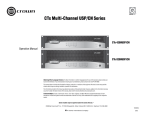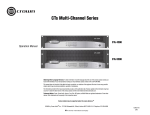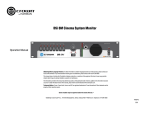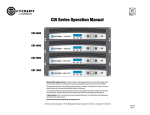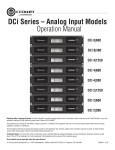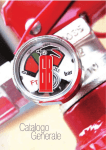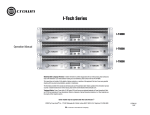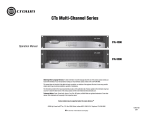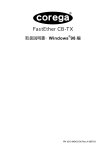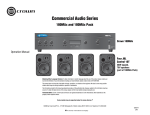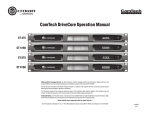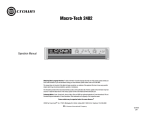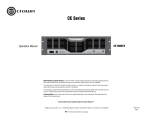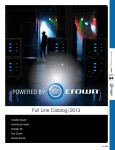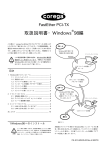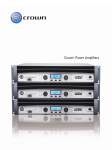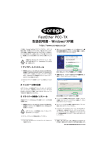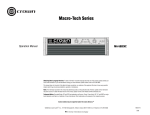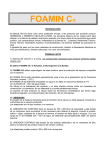Download CTs Multi-Channel USP/CN Series
Transcript
CTs Multi-Channel USP/CN Series CTs 4200USP/CN Operation Manual CTs 8200USP/CN Obtaining Other Language Versions: To obtain information in another language about the use of this product, please contact your local Crown Distributor. If you need assistance locating your local distributor, please contact Crown at 574-294-8000. This manual does not include all of the details of design, production, or variations of the equipment. Nor does it cover every possible situation which may arise during installation, operation or maintenance. The information provided in this manual was deemed accurate as of the publication date. However, updates to this information may have occurred. To obtain the latest version of this manual, please visit the Crown website at www.crownaudio.com. Trademark Notice: Crown, Crown Audio, Amcron, Com-Tech, IQ System, and Multi-Mode are registered trademarks of Crown International. HiQnet and System Architect are trademarks of Harman Pro Group. Other trademarks are the property of their respective owners. Some models may be exported under the name Amcron.® ©2008 by Crown Audio® Inc., 1718 W. Mishawaka Rd., Elkhart, Indiana 46517-9439 U.S.A. Telephone: 574-294-8000 139309-4 10/10 CTs Multi-Channel Power Amplifiers Important Safety Instructions Wichtige Sicherheitsinstruktionen Importantes Instructions de Sécurité Instrucciones de Seguridad Importantes 1. Read these instructions. 2. Keep these instructions. 3. Heed all warnings. 4. Follow all instructions. 5. Do not use this apparatus near water. 6. Clean only with a dry cloth. 7. Do not block any ventilation openings. Install in accordance with the manufacturer’s instructions. 8. Do not install near any heat sources such as radiators, heat registers, stoves, or other apparatus (including amplifiers) that produce heat. 9. Do not defeat the safety purpose of the polarized or grounding-type plug. A polarized plug has two blades with one wider than the other. A grounding-type plug has two blades and a third grounding prong. The wide blade or the third prong is provided for your safety. If the provided plug does not fit into your outlet, consult an electrician for replacement of the obsolete outlet. 10. Protect the power cord from being walked on or pinched, particularly at plugs, convenience receptacles, and the point where they exit from the apparatus. 11. Only use attachments/accessories specified by the manufac turer. 12. Use only with a cart, stand, tripod, bracket, or table specified by the manufacturer, or sold with the apparatus. When a cart is used, use caution when moving the cart/apparatus combination to avoid injury from tip-over. 13. Unplug this apparatus during lightning storms or when unused for long periods of time. 14. Refer all servicing to qualified service personnel. Servicing is required when the apparatus has been damaged in any way, such as power-supply cord or plug is damaged, liquid has been spilled or objects have fallen into the apparatus, the apparatus has been exposed to rain or moisture, does not operate normally, or has been dropped. 15. Use the mains plug to disconnect the apparatus from the mains. 16. WARNING: TO REDUCE THE RISK OF FIRE OR ELECTRIC SHOCK, DO NOT EXPOSE THIS APPARATUS TO RAIN OR MOISTURE. 17. DO NOT EXPOSE THIS EQUIPMENT TO DRIPPING OR SPASHING AND ENSURE THAT NO OBJECTS FILLED WITH LIQUIDS, SUCH AS VASES, ARE PLACED ON THE EQUIPMENT. 18. THE MAINS PLUG OF THE POWER SUPPLY CORD SHALL REMAIN READILY OPERABLE. page 2 To prevent electric shock do not remove top or bottom covers. No user serviceable parts inside. Refer servicing to qualified service personnel. À PRÉVENIR LE CHOC ÉLECTRIQUE N’ENLEVEZ PAS LES COUVERCLES. IL N’Y A PAS DES PARTIES SERVICEABLE À L’INTÉRIEUR. TOUS REPARATIONS DOIT ETRE FAIRE PAR PERSONNEL QUALIFIÉ SEULMENT. IMPORTANT CTs Series amplifiers require Class 2 output wiring. Les amplificateurs de série de CTs exigent des câbles de sortie de classe 2. CTs-Reihe-Verstärker verlangen Klasse die 2 Produktionsverdrahtung. Los amplificadores de la Serie CTs requieren de un cableado de salida Clase 2. Magnetic Field PARA PREVENIR UN CHOQUE ELÉCTRICO, NO RETIRE LAS CUBIERTAS SUPERIOR O INFERIOR. NO EXISTEN PARTES QUE PUEDAN SER REPARADAS POR EL USUARIO AL INTERIOR. REMITA EL SERVICICO AL PERSONAL TÉCHNICAL CALIFICADO. CAUTION! Do not locate sensitive high-gain equipment such as preamplifiers directly above or below the unit. Because this amplifier has a high power density, it has a strong magnetic field which can induce hum into unshielded devices that are located nearby. The field is strongest just above and below the unit. TO COMPLETELY DISCONNECT THIS EQUIPMENT FROM THE AC MAINS, DISCONNECT THE POWER SUPPLY CORD PLUG FROM THE AC RECEPTACLE. THE MAINS PLUG OF THE POWER SUPPLY CORD SHALL REMAIN READILY OPERABLE. If an equipment rack is used, we recommend locating the amplifier(s) in the bottom of the rack and the preamplifier or other sensitive equipment at the top. POUR DÉMONTER COMPLÈTEMENT L’ÉQUIPEMENT DE L’ALIMENTATION GÉNÉRALE, DÉMONTER LE CÂBLE D’ALI MENTATION DE SON RÉCEPTACLE. LA PRISE D’ALIMENTATION RESTERA AISÉMENT FONCTIONNELLE. PARA DESCONECTAR COMPLETAMENTE EL EQUIPO DEL SUMINSTRO ELECTRICO, DESCONECTE EL CABLE DE ALI MENTACION DE LA TOMA DE CA. LAS PATAS DEL CONECTOR DEL CABLE DE ALIMENTACIÓN DEBERAN MANTENERSE EN BUEN ESTADO. WATCH FOR THESE SYMBOLS: The lightning bolt triangle is used to alert the user to the risk of electric shock. The exclamation point triangle is used to alert the user to important operating or maintenance instructions. REGARDEZ CES SYMBOLES: La triangle avec le sigle ‘’foudre’’ est employée pour alerter l’utilisateur au risque de décharge électrique. Le triangle avec un point d’exclamation est employée pour alerter l’utilisateur d’instruction importantes pour lors opérations de maintenance. ATENCION CON ESTOS SÍMBOLOS: El triángulo con el símbolo de rayo eléctrico es usado para alertar al usuario de el riesgo de un choque eléctrico. El triángulo con el signo de admiración es usado para alertar al usuario de instrucciones importantes de operación o man tenimiento. FCC COMPLIANCE NOTICE This device complies with part 15 of the FCC rules. Operation is subject to the following two conditions: (1) This device may not cause harmful interference, and (2) this device must accept any interference received, including interference that may cause undesired operation. CTs Multi-Channel Power Amplifiers DECLARATION of CONFORMITY Crown International, Inc. Issued By: Crown International, Inc. 1718 W. Mishawaka Road Elkhart, Indiana 46517 U.S.A. COMPLIANCE QUESTIONS ONLY: Sue Whitfield 574-294-8289 [email protected] European Representative’s Name and Address: David J. Budge 10 Harvest Close Yateley GU46 6YS United Kingdom Equipment Type: Commercial Audio Power Amplifiers Family Name: CTs Family Model Names: CTs 4200USP/CN, CTs 8200USP/CN EMC Standards: EN 55103-1:1997 Electromagnetic Compatibility - Product Family Standard for Audio, Video, Audio-Visual and Entertainment Lighting Control Apparatus for Professional Use, Part 1: Emissions EN 55103-1:1997 Magnetic Field Emissions-Annex A @ 10 cm and 20 cm EN 61000-3-2:2001 Limits for Harmonic Current Emissions (equipment input current less than or equal to 16 A per phase) EN 61000-3-3:2002 Limitation of Voltage Fluctuations and Flicker in Low-Voltage Supply Systems Rated Current less than or equal to16A EN 55022:2003 Limits and Methods of Measurement of Radio Disturbance Characteristics of ITE: Radiated, Class B Limits; Conducted, Class A CAUTION: Changes or modifications not expressly approved by the party responsible for complicance could void the user’s authority to operate the euqipment. EN 55103-2:1997 Electromagnetic Compatibility - Product Family Standard for Audio, Video, Audio-Visual and Entertainment Lighting Control Apparatus for Professional Use, Part 2: Immunity NOTE: This equipment has been tested and found to comply with the limits for a Class B digital device, pursuant to part 15 of the FCC Rules. These limits are designed to provide reasonable protection against harmful interference in a residential installation. This equipment generates, uses, and can radiate radio frequency energy and, if not installed and used in accordance with the instruction manual, may cause harmful interference to radio communications. However, there is no guarantee that interference will not occur in a particular installation. If this equipment does cause harmful interference to radio or television reception, which can be determined by turning the equipment off and on, the user is encouraged to try to correct the interference by one or more of the following measures: EN 61000-4-3:2001 Radiated, Radio-Frequency, Electromagnetic Immunity (Environment E2, criteria A) Safety Standard: • Reorient or relocate the receiving antenna. I certify that the product identified above conforms to the requirements of the EMC Council Directive 89/336/EEC as amended by 92/31/EEC, and the Low Voltage Directive 73/23/EES as amended by 93/68/EEC. EN 61000-4-2:2001 Electrostatic Discharge Immunity (Environment E2-Criteria B, 4k V Contact, 8k V Air Discharge) EN 61000-4-4:2001 Electrical Fast Transient/Burst Immunity (Criteria B) EN 61000-4-5:2001 Surge Immunity (Criteria B) EN 61000-4-6:2003 Immunity to Conducted Disturbances Induced by Radio-Frequency Fields (Criteria A) EN 61000-4-11:2001 Voltage Dips, Short Interruptions and Voltage Variation IEC 60065: 2001 7th Ed. Safety Requirements - Audio Video and Similar Electronic Apparatus • Increase the separation between the equipment and receiver. • Connect the equipment into an outlet on a circuit different from that to which the receiver is connected. • Consult the dealer or an experienced radio/TV technician for help. Operation Manual Signed Andrew Stump Title: Director of Manufacturing Operation Manual Date of Issue: Jan 1, 2006 DUE TO LINE CURRENT HARMONICS, WE RECOMMEND THAT YOU CONTACT YOUR SUPPLY AUTHORITY BEFORE CONNECTION. page 3 CTs Multi-Channel Power Amplifiers Table of Contents CTs Multi-Channel Power Amplifiers CTs 4200USP/CN Dual Important Safety Instructions ......................................................... 2 3 Operation ......................................................14 8 Network and CobraNet Basics ............................. 33 Declaration of Conformity .............................................................. 3 3.1 Precautions .........................................................................14 8.1. Network Basics ................................................................. 33 1 Welcome ....................................................... 5 3.2 CobraNet and Control Module Features...............................15 8.2 A Closer Look at CobraNet ................................................. 34 1.1 Features .............................................................................. 5 4 Advanced Features ..........................................21 8.2.1 Fast Ethernet............................................................... 34 1.2 How to Use This Manual...................................................... 5 4.1 Using the Aux Connector ....................................................21 8.2.2 Audio Specs ............................................................... 35 2 Setup ........................................................... 6 4.1.1 Aux Output ..................................................................21 8.2.3 Bundles and Audio Channels...................................... 35 2.1 Unpack Your Amplifier ........................................................ 6 4.1.2 Aux Input ....................................................................21 8.2.4 The Conductor............................................................ 35 2.2 Install Your Amplifier .......................................................... 6 4.1.3 Listen Bus Wiring ........................................................21 8.2.5 Repeater Networks...................................................... 35 2.3 Ensure Proper Cooling ........................................................ 6 4.2 Protection Systems ............................................................ 22 8.2.6 Switched Networks...................................................... 35 2.4 Front Panel Controls and Indicators..................................... 7 4.2.1 Thermal Level Control ................................................ 22 9 Service ........................................................ 36 2.5 Back Panel Controls and Connectors .................................. 8 4.2.2 Fault ........................................................................... 22 9.1. International and Canada Service ...................................... 36 2.6 CobraNet and Control Module: 4.2.3 Fault Isolation Topology (FIT) ..................................... 22 9.2 US Service ......................................................................... 36 4.2.4 35-Hz High-Pass Filter ............................................... 22 9.2.1 Service at a US Service Center .................................... 36 2.7 Choose Input Wire and Connectors ..................................... 10 4.2.5 AC Under-Voltage/Over-Voltage Protection ................ 22 9.2.2 Factory Service .......................................................... 36 2.8 Choose Output Wire and Connectors .................................. 10 4.2.6 Power Fuse ................................................................ 22 9.2.3 Factory Service Shipping Instructions......................... 36 2.9 Audio Wiring ....................................................................... 11 4.2.7 Inrush Limiting .......................................................... 22 9.2.4 Packing Instructions................................................... 36 2.9.1 Dual 8/4 Mode ............................................................ 11 4.2.8 Variable-speed Fans ................................................... 22 9.2.5 Estimate Approval....................................................... 36 2.9.2 Dual 70V Mode ........................................................... 11 4.2.9 Switching Power Supply ............................................ 22 9.2.6 Payment of Non-Warranty Repairs.............................. 36 2.9.3 Bridge-Mono 16/8 Mode ............................................ 12 4.2.10 Mode Switch ............................................................ 22 10 Warranty .................................................... 37 2.9.4 Bridge-Mono 100V Mode ........................................... 12 4.2.11 Bridge Mode Indicator.............................................. 22 Product Registration...................................................................... 41 4-ohm (per ch.) 8-ohm (per ch.) 70V (per ch.) 2.10 Network Wiring Rules........................................................ 13 4.2.12 Channel Level Control .............................................. 23 Crown Factory Service Information Form ...................................... 43 1 Channel Driven 2.11 Network Wiring.................................................................. 13 5 Troubleshooting ............................................. 24 2.12 Audio and Aux Wiring........................................................ 13 6 Specifications ............................................... 27 2.13 Connect to AC Mains......................................................... 13 7 AC Power Draw and Thermal Dissipation ................ 31 Connectors, Indicators and Controls..................................... 9 Maximum Average Power in watts with 0.1% THD. 4 Channels Driven 4-ohm (per ch.) 8-ohm (per ch.) 70V (per ch.) 1 Channel Driven 4-ohm (per ch.) 8-ohm (per ch.) 70V (per ch.) 1 kHz 20 Hz–20 kHz 260W 180W 220W 215W 190W 220W* 1 kHz 20 Hz–20 kHz 270W 220W 250W 225W 210W 245W* Bridge-Mono 2 Channel-Pairs Driven 8-ohm (per ch. pair) 16-ohm (per ch. pair) 100V (per ch. pair) 1 Channel-Pair Driven 8-ohm (per ch. pair) 16-ohm (per ch. pair) 100V (per ch. pair) 1 kHz 20 Hz–20 kHz 520W 400W 220W 430W 380W 220W* 1 kHz 20 Hz–20 kHz 560W 440W 250W 450W 420W 245W* * Constant Voltage full bandwidth power ratings support 100Hz - 20kHz due to automatic High-Pass Filters. CTs 8200USP/CN Dual Maximum Average Power in watts with 0.1% THD. 8 Channels Driven 4-ohm (per ch.) 8-ohm (per ch.) 70V (per ch.) 1 kHz 20 Hz–20 kHz 200W 160W 200W 175W 155W 185W* 1 kHz 20 Hz–20 kHz 270W 220W 250W 230W 220W 230W* Bridge-Mono 4 Channel-Pairs Driven 2.14 Startup Procedure.............................................................. 13 8-ohm (per ch. pair) 16-ohm (per ch. pair) 100V (per ch. pair) 1 Channel-Pair Driven 8-ohm (per ch. pair) 16-ohm (per ch. pair) 100V (per ch. pair) 1 kHz 20 Hz–20 kHz 400W 320W 200W 350W 310W 185W* 1 kHz 20 Hz–20 kHz 540W 440W 250W 460W 440W 230W* 1 Welcome 1.1 Features • Crown® Switching Power Supply for reduced weight Building on the foundation of the Com-Tech® Series, Crown’s CTs Series offers new flexibility and value for installed sound applications. The Com-Tech Series were the first to offer independent selection of high- and lowimpedance operation for a specific channel, and CTs Series amplifiers continue that tradition, with power levels and features carefully chosen to perfectly integrate into fixed install design requirements. • High power-density, with eight channels in a 3U chassis and four channels in a 2U chassis Thanks to the factory-installed CobraNet and Control Module, each amplifier is a network component. It connects to the audio control/monitor network using standard 100Mb Ethernet hardware. With this protocol, an audio system can be interconnected using standard off-the shelf 100 Mb Ethernet components (switches, Network Interface Cards, and cables). • 35 Hz High-Pass Filter (70 Hz in CTs 4200) is automatically inserted when the channel pair is set for constant-voltage operation. (corner frequency may be changed as a service option) The Crown CTs 4200USP/CN and CTs 8200USP/CN include SmartAmp features and 3rd-generation DSPbased components. Their SHARC DSP processor gives the user an enormous amount of digital signal processing. Audio routing, faders, meters, polarity & mute, input compressors, filters, multimode output limiters, error reporting, and load monitoring are all available. A built-in noise generator and sine-wave generator provide noise masking and test capabilities. In addition, the amplifier allows the transport of realtime digital audio via CobraNet™ over the same 100Mb Ethernet network that is used for amplifier control and monitoring. This provides a simple to install, singleplug solution for control, monitoring, and fullbandwidth audio distribution. The amplifier can function independently from the network control. Once the processing is configured, the unit’s non-volatile memory allows the amplifier to continue to function with no external control. Please take the time to study this manual so that you can obtain the best possible service from your amplifier. • Selectable constant-voltage (70V/100V) or lowimpedance (8/4 ohm) operation for each channel pair • In the unlikely event of a channel failure, FIT (Fault Isolation Topology) circuitry isolates faults within affected channels • Comprehensive array of indicators including Power and Data, along with Bridge, Ready, Signal, Clip, Thermal and Fault for each channel, provide accurate diagnostics • Blue Power Indicator flashes if the amplifier shuts off due to an under-voltage or over-voltage condition on the AC mains • Advanced protection circuitry guards against: shorted outputs, open circuits, DC, mismatched loads, general overheating, under-voltage or over-voltage, highfrequency overloads and internal faults • Proven Crown AB+B Multi-Mode® output topology • Continuously-variable-speed fans optimize cooling efficiency • Built-in CobraNet and Control Module connects to a CobraNet network. This allows a 100 Mbps Ethernet single-plug solution for CobraNet audio, and HiQnet control and monitoring • Analog audio inputs allow CobraNet network audio input, CobraNet audio backup, or a hardwire emergency override of CobraNet audio • Up to 18 assignable filters per channel • Over 2 seconds of delay available per channel • Input compressors and output limiters for each channel • Noise generator for noise masking • Sine generator • Load supervision • Full error reporting • Firmware upgrades via the network • 10 user selectable presets • Reliable FLASH memory backup of all parameters • Three Year, No-Fault, Fully Transferable Warranty completely protects your investment and guarantees its specifications 1.2 How to Use This Manual This manual provides you with the necessary information to safely and correctly setup and operate your amplifier. It does not cover every aspect of installation, setup or operation that might occur under every condition. For additional information, please consult Crown’s Amplifier Application Guide (available online at www.crownaudio.com), Crown Tech Support, your system installer or retailer. We strongly recommend you read all instructions, warnings and cautions contained in this manual. Also, for your protection, please send in your warranty registration card today, or register online at www. crownaudio.com. And save your bill of sale—it’s your official proof of purchase. • 24 bit digital to analog conversion with 32 bit, floating point DSP processing * Constant Voltage full bandwidth power ratings support 100Hz - 20kHz due to automatic High-Pass Filters. page 4 Operation Manual Operation Manual page 5 CTs Multi-Channel Power Amplifiers CTs Multi-Channel Power Amplifiers 2 Setup (continued) 2 Setup 2.1 Unpack Your Amplifier Please unpack and inspect your amplifier for any damage that may have occurred during transit. If damage is found, notify the transportation company immediately. Only you can initiate a claim for shipping damage. Crown will be happy to help as needed. Save the shipping carton as evidence of damage for the shipper’s inspection. We also recommend that you save all packing materials so you will have them if you ever need to transport the unit. Never ship the unit without the factory pack. YOU WILL NEED (not supplied): • Input wiring cables 2.2 Install Your Amplifier CAUTION: Before you begin, make sure your amplifier is disconnected from the power source, with the power switch in the “off” position and all level controls turned completely down (counterclock wise). Use a standard 19-inch (48.3-cm) equipment rack (EIA RS-310B). See Figure 2.1 for amplifier dimensions. 2.3 Ensure Proper Cooling When using an equipment rack, mount units directly on top of each other. Close any open spaces in rack with blank panels. DO NOT block front, rear or side air vents. The side walls of the rack should be a minimum of two inches (5.1 cm) away from the amplifier sides, and the back of the rack should be open. Figure 2.2 illustrates standard amplifier airflow. You may also stack amps without using a cabinet. NOTE: When transporting, amplifiers should be supported at both front and back. 2.4 Front Panel Controls and Indicators Note: CTs 8200USP/CN is shown. Some CTs 4200 USP/CN features are in different locations. A. Bridge Mode Indicator Yellow LED, one per channel pair, illuminates when the channel pair’s Mode Switch is set to the “Bridge” position. If Mode switch is changed while amplifier is powered up, Bridge LED will flash, indicating that the amplifier must be powered off and on to reset the Mode. B. Ready Indicator Green LED, one per channel, illuminates when the channel is initialized and ready to produce audio output. • Output wiring cables Rack for mounting amplifier (or a stable surface for stacking) C. Signal Indicator Green LED, one per channel, illuminates to indicate the presence of analog input signals above –40 dBu. D. Clip Indicator Red LED, one per channel, illuminates when the THD of the channel’s output signal rises to a level typically considered as the onset of audible clipping. The Clip Indicator also will illuminate during Thermal Level Control (TLC) or input overload. E. Thermal Indicator Red LED, one per channel, flashes when the channel has shut down due to thermal stress or overload. If the power supply goes into thermal overload, all channel LEDs will flash. G. Ventilation Grille Front-to-rear forced airflow. H. Data Indicator Yellow LED flashes whenever a command addressed to the module is received. A similar LED is on the back panel, and the two LEDs flash simultaneously. I. Power Indicator Blue LED indicates amplifier has been turned on and AC power is available. Indicator also flashes if the amplifier shuts off due to an under/over-voltage condition on the AC mains. J. Power Switch Amplifier is on when the switch is in the IN position. F. Fault Indicator Red LED, one per channel, illuminates when the amplifier output channel has stopped operating. WARNING: Before you start to set up your amplifier, make sure you read and observe the Important Safety Instruc tions found at the beginning of this manual. Fault Thermal Clip Power Signal Ready Data 1 Bridge 2 3 Bridge 4 Figure 2.2 Airflow Figure 2.1 Dimensions Left: CTs 4200USP/CN Right: CTs 8200USP/CN page 6 Figure 2.3 CTs 8200USP/CN Front Panel Operation Manual Operation Manual page 7 CTs Multi-Channel Power Amplifiers 2 Setup (continued) CTs Multi-Channel Power Amplifiers 2 Setup (continued) 2.5 Back Panel Controls and Connectors Note: CTs 8200USP/CN is shown. Some CTs 4200USP/CN features are in different locations. K. AC Power Cord Connector Standard IEC type 320 inlet. 120V models: 15-amp. 220-240V models: 10-amp. Voltage is indicated above IEC inlet. L. Output Connectors One four-pole terminal strip for every two channels with touch-proof cover. Accepts up to 10 AWG terminal forks. To connect outputs, first remove the touch-proof cover plate covering the terminal strip by removing the screw which holds it in place. M. USP/CN Module Built into the amplifier, this module allows connection to a CobraNet network. Please see Section 2.6 for details. N. Channel Level Controls One 21-position detented rotary potentiometer per channel, ranging from infinity (-70 dB) to 0 dB attenuation. Refer to Section 4.2.12 for precise dB attenuation increments for each detent. O. Input Connectors Removable Phoenix-style barrier connectors for balanced input. Also can be used as a CobraNet input or a backup for Cobranet (see Section 3.2.6). P. Mode Switch Used on each consecutive pair of channels, this four-position switch is used to select the amplifier’s mode of operation: Dual 8/4 ohms, Dual 70V, Bridge-Mono 16/8 ohms, and Bridge-Mono 100V. IMPORTANT: Be sure to power off the amplifier before change the Modeswitch setting. If this is not done, the Bridge light will flash to indicate that the power must be cycled off and back on to reset the mode. 2.6 CobraNet and Control Module: Connectors, Indicators and Controls D. Data Indicator Flashes when the amplifier receives a valid command that is addressed to the amplifier. See Section 3.2.1. A. AUX Connector AUX input, AUX output, and Foldback. See Sections 3.2.7, 3.2.8, and 4.1. E. CobraNet Network Connectors The dual RJ45 CobraNet connectors allow a Primary & Secondary connection to the 100 Mbps Ethernet network. Should the Primary connection lose link activity with the network, the module will automatically switch to the Secondary connection to ensure uninterrupted audio and control. The indicators on the RJ45 connectors display network information concerning the Ethernet and CobraNet connections. See Sections 3.2.3, 3.2.4, and 3.2.5. B. Preset Indicator Signals the number of the current preset, if active, by flashing a series of flashes equal to the current preset number. See Section 3.2.2. Q. Cooling Vents Front-to-rear forced airflow. C. Reset/Preset Switch Activated by inserting a small item, such as a paper clip, this switch is used to change presets, restore settings to factory default or restore all the presets to the factory defaults. During operations of the switch, the Data indicator flashes as an aid to the user. See Section 3.2.9. A B C D E Figure 2.5 USP/CN Controls, Indicators and Connectors (Note: Actual Product Artwork May Vary Slightly) Figure 2.4 CTs 8200 USP/CN Back Panel (Shown with Touch-proof Cover Removed) page 8 Operation Manual Operation Manual page 9 CTs Multi-Channel Power Amplifiers 2 Setup (continued) CTs Multi-Channel Power Amplifiers 2 Setup (continued) Figure 2.6 Balanced Input Connector Wiring 2.7 Choose Input Wire and Connectors If you will be connecting an analog audio signal to the CTs amplifier, please read this section. Figure 2.6 shows connector pin assignments for balanced wiring, and Figure 2.7 shows connector pin assignments for unbalanced wiring. See the Crown Amplifier Application Guide, available online at www.crownaudio.com, for pin assignments for commonly used connector types. When possible, use balanced wiring for signal input, which provides better rejection of unwanted noise and hum. For more information, refer to the Crown Amplifier Application Guide, available online at www.crownaudio.com NOTE: Custom wiring should only be performed by qualified personnel. Figure 2.7 Unbalanced Input Connector Wiring 2.9 Audio Wiring CAUTION: Never change the position of the Mode Switch while the amplifier power is on. BRIDGE 2.9.1 Dual 8/4 Mode Typical analog input and output wiring, along with level control and Mode Switch settings are shown in Figure 2.9. Make sure the Mode switch is set to the “Dual 8/4” position. Cobranet input wiring is covered in Section 2.11. DUAL DUAL CH 2 CH 1 CH 4 CH 3 DUAL DUAL See the Crown Amplifier Application Guide, available online at www.crownaudio.com, for pin assignments for commonly used connector types. Output panel shown with touch-proof cover plate removed. BRIDGE INPUTS: Connect input wiring for each channel. OUTPUTS: Maintain proper polarity (+/–) on output connectors. 2.8 Choose Output Wire and Connectors Crown recommends using professionally constructed, high-quality, two- or four-conductor, heavy gauge speaker wire and connectors. You may use terminal spade lugs or bare wire for your output connectors (see Figure 2.8). CTs amplifier terminal strips accept up to 10 AWG terminal forks which fit over a #8 screw. For best results, Crown recommends Panduit part #PV10-10LF-L or equivalent terminal spade lug. Screw spacing is shown in Figure 2.8. NOTE: CTs 8200 USP/CN is shown. Some CTs 4200 USP/CN features are in different locations. To connect outputs, first remove the touch-proof cover plate covering the terminal strip by removing the screw which holds it in place. Output panel shown with touch-proof cover plate removed. To prevent the possibility of short-circuits, wrap or otherwise insulate exposed loudspeaker cable and connectors. Also, a touch-proof cover plate, which covers the terminal strips, is provided to help prevent short circuits. The cover plate should be reinstalled after connecting outputs. Distance 2.9.2 Dual 70V Mode CAUTION: Never change the position of the Mode Switch while the amplifier power is on. Figure 2.9 System Wiring and Control Settings, Dual Mode, 8/4 Ohm 70V Typical input and output wiring, along with level control and Mode Switch settings are shown in Figure 2.10. Make sure the Mode switch is set to the “Dual 70V” position. INPUTS: Connect input wiring for each channel. BRIDGE 70V DUAL DUAL CH 2 CH 1 CH 4 CH 3 DUAL DUAL OUTPUTS: Maintain proper polarity (+/–) on output connectors. Suggested below are guidelines to select the appropriate size of wire based on the distance from amplifier to speaker. Check with local code as this may vary. up to 25 ft. (7.6 m) 26-40 ft. (7.9-12.2 m) 41-60 ft. (12.5-18.3 m) Over 60 ft. (18.3 m) Connect the Channel 1 speaker’s positive (+) lead to amplifier Channel 1 positive terminal; repeat for negative (–). Repeat each channel wiring as for Channel 1. Connect Channel 1 positive (+) speaker load to Channel 1 positive terminal of amp; repeat for negative (–). Repeat each channel wiring as for Channel 1. Wire Size 16 AWG 14 AWG 12 AWG 10 AWG Output panel shown with touch-proof cover plate removed. BRIDGE CAUTION: Never connect the speaker return to the chassis of the amplifier, or damage to the amplifier may result. CAUTION: Never use shielded cable for output wiring. page 10 Figure 2.8 Output Connector Wiring (Typical of Two Channels) Figure 2.10 System Wiring and Control Settings, Dual Mode, 70V Operation Manual Operation Manual page 11 CTs Multi-Channel Power Amplifiers 2 Setup (continued) 2.9.3 Bridge-Mono 16/8 Mode CAUTION: Never change the position of the Mode Switch while the amplifier power is on. See the Crown Amplifier Application Guide, available online at www. crownaudio. com, for pin assignments for commonly used connector types. BRIDGE DUAL DUAL CH 2 CH 1 Typical analog input and output wiring, along with level control and Mode Switch settings are shown in Figure 2.11. Make sure the Mode switch is set to the “Bridge 16/8” position. INPUTS: Connect input wiring only to the lower(odd-) numbered channel pair. CH 4 CH 3 DUAL DUAL CTs Multi-Channel Power Amplifiers 2 Setup (continued) 2.10 Network Wiring Rules IMPORTANT: Please read the wiring rules below before installing the wiring. Connect each device to the network through its own cable in a Star Network (Figure 2.13). Do not connect them in a serial fashion. Make sure each device has its own Category 5 certified cable connecting it to a central concentrator, most often a switch. Figure 2.11 System Wiring and Control Settings, Bridge-Mono Mode, 16/8 Ohm. 2. Connect the AUX wiring if used. See Section 4.1 for more information. 2.13 Connect to AC Mains Connect your amplifier to the AC mains power source (power outlet) with the supplied AC power cordset. First, connect the IEC end of the cordset to the IEC connector on the amplifier; then, plug the other end of the cordset to the AC mains. BRIDGE DUAL DUAL CH 2 CH 1 WARNING: The third prong of this connector (ground) is an important safety feature. Do not attempt to disable this ground connection by using an adapter or other methods. INPUTS: Connect input wiring only to the lower(odd-) numbered channel pair. NOTE: When operating the channel pair in Bridge-Mono mode, turn down (full CCW) the level control for the higher (even)-numbered channel of the channel pair. The lower (odd)numbered level control works both channels. page 12 HiQnet control is available over the CobraNet network using Harman Pro System Architect software. The software can set up CobraNet audio routing and addressing. In System Architect, the analog balanced audio inputs can be set up to act either as CobraNet backup, an emergency override of CobraNet audio, or as an audio input to the CobraNet network. 2.9.4 Bridge-Mono 100V Mode CAUTION: Never change the position of the Mode Switch while the amplifier power is on. OUTPUTS: Connect the speaker across the positive terminals of each channel pair. Do not use the negative terminals of the channel pair when the pair is being operated in Bridge-Mono mode. If network redundancy is required, use a standard CAT5 cable to connect the Secondary CobraNet connector to a 100Mb port on the auxiliary CobraNet network. 2.12 Audio and Aux Wiring 1. Connect the Audio Input Wiring. The amplifier is equipped with removable barrier block connectors for each channel’s input. See Section 2.7 for more detail on audio wiring. 100V Typical analog input and output wiring, along with level control and Mode Switch settings are shown in Figure 2.12. Make sure the Mode switch is set to the “Bridge 100V” position. Crown strongly recommends the use of a 100 Mb Ethernet network for control and monitoring. configurations. Also, the amplifier must be run within the specified mains frequency requirements (indicated on the amplifier’s back panel label). If you are unsure of the output voltage of your AC mains, please consult your electrician. The various models have the following under-voltage limits and over-voltage limits: Models Under-Voltage Limit Over-Voltage Limit 100VAC (CTs 8200USP/ CN only) 90VAC 110VAC 120 VAC units 108VAC 132VAC BRIDGE OUTPUTS: Connect the speaker across the positive terminals of each channel pair. Do not use the negative terminals of the channel pair when the pair is being operated in Bridge-Mono mode. NOTE: When operating the channel pair in Bridge-Mono mode, turn down (full CCW) the level control for the higher (even)-numbered channel of the channel pair. The lower (odd)numbered level control works both channels. 2.11 Network Wiring Use the cable to connect the Primary CobraNet connector to a 100 Mb port on the Ethernet switch that is used to form the CobraNet network. For more detail, see Section 3.2.3. We highly recommend that the CobraNet be a standalone or separate-network LAN. CH 4 CH 3 DUAL DUAL Amplifiers don’t create energy. The AC mains voltage and current must be sufficient to deliver the power you expect. If the AC line voltage varies out of an acceptable range, the amplifier’s power supply turns off and the blue Power LED flashes. The amplifier will turn back on when the AC line voltage returns to safe operating levels. Figure 2.14 provides voltage limits for all amplifier AC voltage BRIDGE Figure 2.13 An Example of a Star Network 220V/230V/240V units 198VAC 264VAC 2.14 Startup Procedure Use the following procedure when first turning on your amplifier: 1. Turn down the level of your audio source. 2. Turn down the level controls of the amplifier. 3. Turn on the “Power” switch. The Power indicator should glow. 4. Turn up the level of your audio source to an optimum level. 5. Turn up the Level controls on the amplifier until the desired loudness or power level is achieved. 6. Turn down the level of your audio source to its normal range. If you ever need to make any wiring or installation changes, don’t forget to disconnect the power cord. Figure 2.12 System Wiring and Control Settings, Bridge-Mono Mode, 100V Operation Manual Operation Manual page 13 CTs Multi-Channel Power Amplifiers CTs Multi-Channel Power Amplifiers 3 Operation (continued) 3 Operation 3.2 CobraNet and Control Module Features 3.1 Precautions Your amplifier is protected from internal and external faults, but you should still take the following precautions for optimum performance and safety: 1. Before use, your amplifier first must be configured for proper operation, including input and output wiring hookup. Improper wiring can result in serious operating difficulties. For information on wiring and configuration, please consult the Setup section of this manual or, for advanced setup techniques, consult Crown’s Amplifier Application Guide available online at www. crownaudio.com. 2. Use care when making connections, selecting signal sources and controlling the output level. The load you save may be your own! 3. Do not short the ground lead of an output cable to the input signal ground. This may form a ground loop and cause oscillations. 3.2.1 Data Indicator An amber Data Indicator flashes whenever a command addressed to the module is received. To assist with troubleshooting, an option that forces the Data Indicator to remain lit is available through the software. In addition, the locate feature in System Architect will cause the Data Indicator to blink rapidly to help you identify the unit. Another Data Indicator is on the amplifier’s front panel, and it lights simultaneously with the module’s Data Indicator. 4. WARNING: Never connect the output to a power supply, battery or power main. Electrical shock may result. 5. Tampering with the circuitry, or making unauthorized circuit changes may be hazardous and invalidates all agency listings, and may also void the product’s warranty. 6. Do not operate the amplifier with the red Clip LEDs constantly flashing. 7. Do not overdrive the mixer, which will cause clipped signal to be sent to the amplifier. Such signals will be reproduced with extreme accuracy, and loudspeaker damage may result. 8. Use caution when operating the amplifier with a 2-ohm load impedance on 1 channel. Do not operate the amplifier with less than a 2-ohm load impedance per channel when driving more than 1 channel. Due to the amplifier’s output protection, such a configuration may result in premature clipping, speaker damage or a blown power fuse. Remember: Crown is not liable for damage that results from overdriving other system components. 3.2.2 Preset Indicator A green Preset indicator signals the number of the current preset, if active, by continually flashing a series of flashes equal to the current preset number, followed by a pause. A preset is considered “active” if the USP/CN settings match those in the selected preset. If a change is made to any setting then the preset is considered “inactive,” and the indicator stops flashing. 3.2.3 CobraNet Network Connectors The Primary and Secondary CobraNet RJ-45 connectors can simultaneously interface to the 100 Mbps HiQnet network. While the Primary CobraNet connector is the main connection to the network, the Secondary connector is the “backup” or redundant connection to the network. If the Primary connection fails due to cut wire, failed network switch, etc., this port is automatically enabled and ready to receive the network data within a few seconds. Make connections with a standard CAT5 cable to a network switch port. Crown strongly recommends the use of switches and not hubs in the network. Hubs will limit the amount of CobraNet traffic and create unnecessary limitations in the network. If the amplifier is not connected to a network, the CobraNet connector can connect directly to a computer’s network adapter port using a crossover cable (TX and RX pairs swapped). 3.2.4 Link/Activity Indicator The green Link/Activity indicator is provided on the network connector to display the status of the Ethernet connection. Whenever the module is properly connected to another functioning network port, the indicator lights. When the module detects the presence of network traffic, the indicator flashes. The Link/Activity LED flashes for all network traffic, while the Data LED flashes only for commands addressed to this USP/CN. page 14 Operation Manual Operation Manual .3.2.5 CobraNet In-Use/Conductor Indicator The indicator on the right side of each CobraNet RJ-45 connector turns ON if the port is in-use (i.e. the link is being used to transmit or receive active CobraNet traffic), and will blink if the device is also the conductor (the timing reference). 3.2.6 Balanced Audio Inputs Located on the amplifier rear panel, these removable barrier-block connectors allow line-level audio signals to be input to the USP/ CN. The amplifier accepts line-level analog audio signals in addition to the digital audio from the CobraNet network. This analog audio can be used for one of three purposes: • Backup of the CobraNet network audio: In the unlikely event of a loss of CobraNet audio to the module, the module automatically switches over to the balanced audio inputs. • Emergency override: If an audio signal appears at the analog inputs, the module switches to that signal. • CobraNet network audio inputs: The amplifier can act as a CobraNet audio input source by converting the balanced audio input signal to CobraNet. 3.2.7 Aux Input/Output Connector An RJ-11 connector provides three functions: AUX output, AUX input and Foldback. The AUX output is a multifunctional control output that delivers 15 VDC limited to 15 mA. It can be configured in two modes: • Manual mode: The output is simply controlled with a command from the software. • Error reporting mode: The AUX out is active when the module detects an error. Each error source (Thermal, Clip, Load, Amp Fault, and Line Voltage) can be individually enabled to activate the AUX output when the error conditions are met. An inversion control allows the AUX output functionally to be inverted for the manual and error reporting modes. The inversion control is ignored for flash preset mode. The AUX input is a two-state input with a high state defined as voltage between 4 and 15 VDC. The low state is defined as voltages between 0 and 1.6 VDC. It has a 10K input impedance. The AUX input can be configured in several modes: • None: In this mode the module makes no changes to its operation. However, the AUX input status can be monitored through the control software and used for functions within the software. • Mute All: This mutes the channels when the AUX input is active. Likewise, the Power Off Both function disables both channels during an active AUX input. • AUX Input Inversion: This control allows the low state to activate the selected function. Normally, the high state activates the selected AUX input function. The AUX port provides a power supply for the AUX input. This 15 VDC at 15 mA supply can be connected through a switch to the AUX input. This allows a simple switch closure to operate the aux input without the need of an external power supply. See Section 4.1 for details on using the AUX port. 3.2.8 Listen Bus or Foldback The AUX port is also used for the Foldback connection. Two pins of the connector provide a balanced line-level audio output that can be selectively driven by either channel under System Architect software control. 3.2.9 Preset/Reset Switch The Preset/Reset switch is a recessed pushbutton located between the Data and Preset indicators. It is activated by a straightened paper clip or similar object. This switch can be used to change presets, restore settings to factory default or restore all the presets to the factory defaults. During operations of the switch, the Data indicator flashes as an aid to the user. To select a preset: 1. Remove all audio input signals. 2. With the amplifier powered up, momentarily hold the preset switch in for one flash of the Data indicator (less than 2 seconds) and then release. 3. The amplifier will load the next preset in the defined preset range. The range of presets is defined by the Maximum Preset and Minimum Preset controls. Once the Maximum Preset is reached, the next momentary depression of the switch will cycle the USP/ CN to the Minimum Preset. 4. The Preset indicator will flash the number of the selected preset followed by a pause. 5. Restore the audio input signals. To restore the unit to factory default settings: 1. Remove all audio input signals. page 15 CTs Multi-Channel Power Amplifiers 3 Operation (continued) 2. Hold the Reset/Preset switch in for two flashes of the Data light (longer than 2 seconds). 3. The Data indicator will flash rapidly for a moment. 4. Restore the audio input signals. To restore the unit including presets to factory default settings: 1. Remove all audio input signals. 2. Hold the Reset/Preset switch while applying power to the unit. 3. The Data and Preset indicator will both light. 4. Release the switch within 5 seconds (before the Data and Preset indicators go out). 5. The Data indicator will flash rapidly for a moment. 6. Restore the audio input signals. 3.2.10 User Presets The control settings for all the functions can be stored as presets. A total of ten presets can be saved in the USP/CN’s nonvolatile memory. Each preset can be named with a 30 character name describing its function, which is also stored in the USP/CN’s memory. • The Store Preset Control saves the current setting to the specified preset. • The Recall Preset Control recalls the specified preset settings. • The Preset Valid Monitor indicates if a change has been made to any setting since the last time a preset has be saved or recalled. • The Last Stored or Recalled Preset Monitor indicates what the Last Stored or Recalled preset is. 3.2.11 Clip Event Monitor A clip detector is provided each channel. These monitors will indicate any clip condition (> 0.05% distortion) in the amplifier channel. The clip detectors also can indicate certain errors (See Section 3.1.25). 3.2.12 Input Signal Level Monitor The input signal level of each channel can be monitored via System Architect software. The measurement range is from +20 dBu to –40 dBu with 0.5 dBu resolution. Each audio channel has the following monitors: • Analog audio input: The audio input at the Balanced Audio Inputs. • Switched audio input: The audio input after the Input Audio Router. page 16 CTs Multi-Channel Power Amplifiers 3 Operation (continued) • CobraNet audio input: The audio input level from the selected CobraNet audio channel. set by the user to indicate the function of the amplifier and its channels. For example, “LOWER RIGHT CLUSTER, FOR DELAY.” 3.2.13 Output Signal Level Monitor The output signal level of each channel can be monitored via System Architect software. The measurement range is from 0 dB to –40 dB with 0.5 dB resolution. The monitors are scaled so that 0 dB is referenced to the full rated output voltage of the amplifier. 3.2.21 Line Voltage Monitor The AC line voltage supplied to the amplifier can be monitored with this function. If the voltage is out of a safe area you can trigger an error. 3.2.14 Thermal Headroom Level Monitor The thermal headroom level of each channel can be monitored with the software. This level represents the percent of available power/thermal capacity that is currently being used within the output section of the amplifier. When the thermal headroom level reaches 100%, the amplifier cannot produce any more power and it will begin to protect the output devices by limiting their drive level. The thermal limiter feature of the USP/CN can be set to engage at a pre-selected thermal level. (See Section 3.2.31). 3.2.15 Power/Standby Control Each channel can be independently turned on and off. 3.2.16 Signal Mute The output signal of each channel can be independently muted. This function produces a minimum 60 dB of attenuation. 3.2.17 Polarity Inverter The input signal polarity of each channel can be independently inverted. 3.2.18 Input Signal Fader Each input signal can be adjusted under software control. The gain range is +20dB to –100dB in 0.5 dB steps. Each analog Audio Input has two faders with these functions: • Trim the Analog Audio Input signal before the Input Router. • Trim the Analog Audio Input signal after the Input Router. 3.2.19 Amplifier Information At startup, the module extracts several useful items of information about the host amplifier. These include manufacturer, model, date code, and serial number. This information is stored in the software system inventory and is displayed on the software control panels. 3.2.20 User and Channel Labels In IQwic, the module can store two user labels and channel labels. In System Architect, the module can store 4 or 8 channel labels and a unit label.These labels are 30-character strings that can be 3.2.22 Error Reporting The module can detect three different error conditions per channel and errors in the AC line voltage. Each error type can be configured to report the error through the control network and/or the AUX port. Network reported errors appear in the control software’s Error Window. The software offer many options to further report errors, including audible alerts, printout, email, pager, serial port and fax. The options are set in the software. The following describes each error source. CLIP: The USP/CN can be configured to report if an excessive number of clip events occur in either amplifier channel. The clip events are consider an error if they exceed the defined count per the defined unit of time. The Count Control sets the maximum number of events before the error is reported. The range is 1 to 100. The Time Control defines the amount of time that the events are counted before starting the counting process over. Its range is 1 to 10 seconds. Note: Clip events are defined as the start of each clip and every 10 milliseconds the amplifier is in clip thereafter. Using a high count setting with a short time setting may result in clip error never being detected. THERMAL: Errors can be generated for excessive temperature in the output section of the amplifier channel. The Threshold Control sets the level that, if exceeded, will generate the error report. This control has a range of 1 to 100%. LOAD: If the load monitoring feature is activated, an error report can be generated if the load impedance moves outside the pre-selected range. See Section 3.1.33 for instructions on setting up load monitoring. LINE VOLTAGE: The AC line voltage can be monitored and an error generated whenever the voltage is outside of the limits set at the factory. Operation Manual 3.2.23 Input Signal Compressor/Limiter An input signal compressor/limiter is available for each channel. Five parameters control this feature: Enable: Enables or disables this function. Release Time: Sets the release time of the compressor. The release time is defined as the time it takes the limiter to increase the output signal by 20 dB. The range is from 10 milliseconds to 10 seconds. Threshold: Sets the level, in dBu, above which the compressor begins to attenuate the input signal. This level corresponds to the input level meter reading. The compressor is “feed-forward,” meaning that the level detection point is located before the gain control stage. The range is from +20 dBu to – 50 dBu. 3.2.25 RMS Power Limiter This limits the long-term output power of the amplifier. Four parameters control this limiter for each channel: Enable: Enables or disables this limiter. Threshold: Sets the average power level, in watts, which the limiter will allow from the amplifier channel. The range is from 10 watts to 600 watts. This level should be set to the connected loudspeaker’s long-term power rating. Attack Time: Sets the attack time of the compressor. The attack time is defined as the time it takes the compressor to attenuate the signal gain by 20 dB. The range is from 1 millisecond to 0.1 second. Report Error to Network: Enables Error Reporting to send an error report via the network so that high and low load conditions are reported to the software. Report Error to Aux: Enables and high or low load error to be reported by the AUX output. (See Section 4.1.1). Test Indicator: This indicator is active when the amplifier output signal is sufficient to allow load impedance calculation and test verification. Release Time: Sets the release time of the compressor. The release time is defined as the time it takes the limiter to increase the output signal by 20 dB. The range is from 1 second to 30 seconds. Low/Normal/High Indicator: This indicator shows the present status of the load impedance with respect to the user-defined high and low limits. 3.2.26 Load Supervision The load supervision feature allows real-time monitoring of the load connected to each amplifier channel. When enabled, the USP/CN continuously monitors the amplifier output voltage and current, and calculates the long-term average load impedance. The measured load impedance is compared against the userdefined high and low limits. If either limit is exceeded, the status indicator and, if enabled, the System Architect Error Reporting functions alert the user of the problem. There are six controls and two indicators for each channel: Z Average Monitor: Reports the actual calculated average load impedance in ohms. Its range is from 0 ohms to 250 ohms. Compression Ratio: Sets the compression ratio of the compressor. The ratio is the relation between the amount of attenuation applied by the compressor verses the amount that the input signal is over the threshold. The available settings are 2:1 to 32:1. 3.2.24 Peak Voltage Limiter This limits the peak voltage output of the amplifier. Four parameters control this limiter for each channel: Enable: Enables or disables this function. Threshold: Sets the level, in absolute voltage, which the limiter will allow from the amplifier. The range is from 12 Vpk to 255 Vpk. Operation Manual Nominal Load Impedance: Sets the expected average impedance for the connected load. This value determines the output signal level required for the test. This parameter is also used by the average power limiter to determine the expected power threshold. (See Section 3.1.29). Attack Time: Sets the attack time of the limiter. The attack time is defined as the time it takes the limiter to attenuate the output signal by 20 dB. The range is from 1 second to 30 seconds. Release Time: Sets the release time of the compressor. The release time is defined as the time it takes the compressor to increase the signal gain by 20 dB. The range is from 10 milliseconds to 10 seconds. Attack Time: Sets the attack time of the limiter. The attack time is defined as the time it takes the limiter to attenuate the output signal by 20 dB. The range is from 1 millisecond to 100 milliseconds. Low Limit: Sets the lower bound below which the system will report a “low” error status. Enable: Enables or disables the load-supervision function. High Limit: Sets the upper bound above which the system will report a “high” error status. Load Supervision Applications The Load Supervision feature can be used to monitor the amplifier load in real time with almost any program material. Average load impedance is calculated as a function of amplifier output voltage and current. The system requires approximately 20-30 mA of average amplifier output current for adequate supervision. This allows typically low average output power levels of less than ½ watt with most loads. The maximum load impedance for reliable system performance is limited to about 50 ohms. Higher impedances can be measured but may require higher amplifier output levels for reliable operation. page 17 CTs Multi-Channel Power Amplifiers 3 Operation (continued) Most amplifier/load systems can be configured and supervised by following these steps: 1. Configure your audio system using a known “good” load, then enable the Load Supervision feature. 2. Provide typical program material at a level high enough to light the “test” indicator. 3. Run the system at this level until the average impedance stabilizes. This may take seconds to minutes depending on level, duty-cycle, etc. 4. Set the nominal impedance at the measured value average. This optimizes the supervision algorithm for voltage and current levels versus the actual load. Note: a higher nominal setting will require higher output levels. 5. Set the high limit at twice average and the low limit at onefourth nominal. (These limits are somewhat arbitrary but should be a good starting point.) 6. Let the system run for extended periods using any and all typical program material. 7. Adjust the high/low limits, if necessary, to account for any variance in average measured impedance. 8. Enable error reporting, if desired. This procedure should work well for most applications. However, some applications can be a little more difficult. Some very lowlevel and/or low duty-cycle signals may not adequately “test” the load. Lab and situation testing have shown output levels as small 40 dB below rated amplifier output to be enough for most lowimpedance loads. Higher impedance loads such as those used in “lightly-loaded” 70V distribution lines may require signal level near 20 dB below rated output. The “Nominal Load Impedance” control is used to optimize the system for the most accurate calculation of load impedance. It should be set to the expected nominal (or rated) impedance of the “normal” load. The high limit should be set for at least 2 times the expected nominal or actual measured load, while the low limit should be set to ½ the expected nominal or actual measured load. The following example calculates the SPL necessary for supervision of a typical 8-ohm system. While the resulting 80-dB SPL @ 1 meter is definitely above conversation level, it is not uncomfortable. page 18 CTs Multi-Channel Power Amplifiers 3 Operation (continued) An “8 ohm” example: 30 mA into 8 ohms = 0.007watt. 8-ohm driver sensitivity = 100dB for 1W @ 1 meter. 0.007W/1W = –20dB. Required SPL for supervision test is 100dB – 20dB = 80dB SPL @ 1 meter. 3.2.27 Typical Load Characteristics It is well known that the typical loudspeaker impedance is not the same for all frequencies. This variance is due to the effect of electrical properties such as the expected increase in impedance at high frequencies due to driver voice-coil inductance, or the peaks and valleys due to passive crossovers. Testing of various passive boxes has shown peaks of 100 ohms or more! Lowfrequency impedance variation can come from the interaction of the driver compliance with that of the box. The low frequency variations are usually wide bandwidth and may vary from 6 to 30 ohms on an 8-ohm driver. These anomalies are easily averaged out by the USP/CN supervision algorithm in most systems. However, there may be some extreme situations for very narrow bandwidth (i.e. singlenote) signals and/or very widely varying loads that the algorithm simply cannot overcome. In these cases, widening the high and low limits will help decrease the “sensitivity” of supervision and decrease the chance of “nuisance” error reports. 3.2.28 Filters Each audio channel has five separate places where filters can be placed in the system. There are 64 filters total and they can be placed anywhere within the system. In addition to filtering, each possesses up to ± 24 dB of gain. The filters will vary based on the firmware and software being run. The following filters are available: • Lowpass: Bessel 2-4, Butterworth1-4, and Linkwitz-Riley 4 (Firmware 2.0 provides up to 8 Linkwitz-Riley filters) • Highpass: Bessel 2-4, Butterworth1-4, and Linkwitz-Riley 4 (Firmware 2.0 provides up to 8 Linkwitz-Riley filters) • Lowshelf: Low-frequency shelving EQ • Highshelf: High-frequency shelving EQ • Lowpass EQ: Variable Q from 0.1 to 35 • Highpass EQ: Variable Q from 0.1 to 35 • Parametric EQ: Variable Q from 0.1 to 35 • All-Pass: 1st and 2nd order All-Pass filters provide no gain change to the output, but provide a phase change at the selected frequency. This corrects the phase relationship of the output without a gain reduction, such as is found in other filters. CobraNet Audio: Assign this in the CobraNet Input section of the software. See Section 3.3.2 for more details. Choices for the CobraNet Input are from any of four bundles, and any of the eight channels available. 3.2.29 Delay Due to the nature of DSP processing, there is some inherent delay or latency within the system These delays are: CobraNet with Analog Backup: In this mode, if CobraNet audio is lost, the module automatically switches to the chosen Balanced Audio Input until CobraNet audio returns. DSP processing: 1 ms or 1000 µs. Digital-to-analog conversion: 250 µs. Analog-to-digital conversion: 250 µs. Amplifier: 100 µs. CobraNet with Analog Override: In this mode, if a signal appears on the Analog Input, the module’s input signal switches from CobraNet to the Analog Input. Then the CobraNet audio will be routed to the channel after 10 seconds. In addition to these unavoidable delays, additional delay can be added to each channel. Each channel is capable of 2.0 seconds of delay in 20.8 µs increments. Overall delay = inherent delay + coarse delay + fine delay. 3.3 CobraNet CobraNet is a licensed technology developed by Peak Audio, Inc. consisting of proprietary communications protocol, firmware and hardware. It allows reliable, deterministic transmission of digital audio over a 100Base-T Fast Ethernet network. The amplifier operates as a networked device on a CobraNet network, and interfaces digital audio from the network to the amplifier. For a more thorough discussion about CobraNet technology, refer to Section 8.2 and visit Peak Audio’s CobraNet website at www. cobranet.info. 3.2.30 Noise Generator A noise generator shared between channels allows noise to be mixed into the audio signal. This is useful for noise masking applications and testing. Each channel has the following controls: • Noise On/Off: The channel’s noise generator can be independently turned on. • Noise Type: Full spectrum white noise or pink noise. • Noise Level: A fader to allow the noise level to be controlled. 3.2.31 Sine-wave Generator A sine-wave signal generator allows the mixing of a single tone into the audio signal. Typical applications can be for the injection of a high frequency tone (19 kHz) into the signal in paging type system to continually drive the speaker, allowing continuous monitoring of the speaker load. The following controls exist: • Sine On/Off: The sine-wave signal generator’s function. • Sine Frequency: Controllable from 20 Hz to 20 kHz. • Sine Level: Each channel’s sine-wave signal level can be independently controlled. 3.2.32 Input Signal Router Each channel of the module’s signal processing has an Input Signal Router that lets you choose the audio signal that will be used by the channel. Choose one of the following configurations: Operation Manual This section describes the amplifier’s CobraNet control and monitoring features. These features are accessed via the control software. Please refer to the software documentation if you are unfamiliar with the software. 3.3.1 CobraNet Module Parameters The internal CobraNet Network Interface Module contains several parameters for control and monitor of status of the CobraNet network, and do not directly affect the control network. These variables can also be controlled and monitored through the CobraNet network using CobraCAD™ or other industry-standard SNMP-enabled network management software. CobraCAD is software that provides a GUI to design CobraNet networks. It can be downloaded from www.peakaudio.com. Operation Manual Conductor The Conductor is the device in a CobraNet network that acts as the master clock. Other devices are called “Performers.” Any CobraNet device can be configured to operate either as Network Conductor or a Performer. • Active Indicator: This indicator, viewable in System Architect software, reports the present Conductor status of the device. If the indicator is ON, the unit is operating as the network Conductor. When OFF, the unit is operating as a Performer. • Priority: This parameter adjusts the priority level for becoming the Conductor. When set to zero, the amplifier will never function as the Conductor, and when set to 255 it will always function as the Conductor. The higher the priority number, the more likely unit will act as the Conductor. The Priority object is stored in presets. System Name This parameter can be set to any alpha-numeric string of 30 characters or less. It communicates a unique name for the particular device to a network. The System Name object is stored in presets. System Description This parameter is configured at the factory and is read-only. The intended use is to communicate a unique device description to a network. System Location This parameter is user-settable to any alpha-numeric string of 30 characters or less. The intended use is to communicate a unique description of the device location to a network. This object is stored in presets. System Contact This parameter is user-settable to any alpha-numeric string of 30 characters or less. The intended use is to communicate the designated contact person (in case of service or other network issue) to the network. This object is stored in presets. Firmware Version This parameter is configured at the factory and is read-only. The intended use is to communicate the presently loaded CobraNet module firmware version to a network. MAC Address This parameter is configured at the factory and is read-only. The setting defines a unique IEEE802-recognized address for use with any Ethernet based network. IP Address This IP address is for the CobraNet control ONLY. It is used by SNMP agents such as CobraNet Disco to control CobraNet specific functions. This IP address should not be confused with the control system’s IP address that is used to control and monitor the CobraNet module. 3.3.2 CobraNet Input Routing CobraNet input routing includes the following controls: CobraNet Receive Bundles The amplifier can receive four unique CobraNet Bundles (RxA, RxB, RxC, RxD). Each Bundle includes an “Active” indicator to indicate whether the particular Bundle is being actively transmitted onto the network. CobraNet Receive Channels Each CobraNet Bundle contains up to eight digital audio channels. Each channel is selected at its respective transmitter to contain none, 16-, 20or 24-bit audio sample data. A total of four or eight audio channels can be processed by the USP/CN at any one time. Any of the eight channels on a bundle can be can be routed to either of the four or eight processing channel inputs on the USP/CN. • Channel Label: Each received digital audio channel can be assigned a user-specified label to indicate intended use, source or other information. The label is stored in presets along with the bundle number and receive channel information. page 19 CTs Multi-Channel Power Amplifiers 4 Advanced Features 3 Operation (continued) 3.3.3 CobraNet Output Routing CobraNet output routing includes the following controls: CobraNet Transmit Bundles The amplifier can transmit up to four unique CobraNet Bundles (TxA, TxB, TxC, TxD). Each Transmit Bundle includes the following controls and monitor functions: • Receiver Count: This meter reports the number of CobraNet nodes actively receiving the Bundle being sourced to the network by this bundle. • Transmit Priority: This control adjusts the relative priority for the particular transmitter. Higher numbers indicate a higher priority. One may choose to increase the transmitter priority for an emergency page microphone in a heavily loaded network. The Transmit Priority object is stored in presets. CTs Multi-Channel Power Amplifiers CobraNet Transmit Channels Each CobraNet Bundle can contain up to eight unique digital audio channels. Each channel is selected at its respective transmitter to contain none, 16-, 20- or 24-bit audio sample data. A total of 32 channels can be transmitted by a single USP/CN at any one time; however, only 4 channels can be sent on up to four Bundles. The CobraNet Transmit Channel object is stored in presets. Here are some features of CobraNet Transmit Channels: • Output Amplifier Audio: By sampling the actual output audio of the amplifier, CobraNet allows remote access and monitoring of each amplifier channel at the output of the amplifier! CobraNet extends the “Listen Bus” or foldback feature found on other PIP modules to any network user, allowing them to listen to the output of any networked amplifier from any location on the network. • Balanced Audio Inputs: Analog audio entering the Balanced Audio Inputs can be converted to digital, and sent onto the CobraNet network. This provides a very cost-effective means of CobraNet input. 4.1 Using the AUX Connector The AUX connector offers a means to tap some of the flexibility of Harman Pro System Architect. It can be used to enable peripherals, send a signal to another system component, and send a line-level audio signal of the amplifier’s output. The AUX connector is an RJ-11 type. Pins 3 and 4 are used as a control output. Pins 2 and 3 function as a control input. Pin 5 is a voltage supply pin for use with the control input. 4.1.1 AUX Output The AUX output provides a +15 VDC output, current limited to 10 mA, which can be switched on or off under software control. In its basic mode, the AUX output can be used to control auxiliary equipment. To control AC-line-powered equipment the AUX output must actuate a relay. The relay would then turn on the auxiliary equipment. See Figure 4.1. The AUX output has two enhanced modes: Error Reporting and Flash Preset. In Error Reporting mode, the AUX port can be set up to change state when any selected error (clip, thermal, amp fault, load impedance, and AC line level) is detected. With this feature, the AUX output of each amplifier can be wired to a separate light on a panel at the control location to indicate whether the amplifier is or is not in error. Generally, the AUX output inverter is used for such a system. This way if the panel light is on the operator knows “all is well”. If it is off the operator knows the amplifier has an error or that it is not powered. The other enhanced AUX output mode is Flash Preset. This mode allows remote indication of the selected preset. In this mode, the AUX output will flash a number of times equal to the selected preset followed by a pause. By using the Change Preset AUX input mode and the Flash Preset AUX output mode, this allows a remote panel to function as a preset controller. The panel would contain a simple light and pushbutton connected to the AUX output and input. See Figure 4.2. 4.1.2 AUX Input In its basic input mode, the AUX input allows an external input source to be detected by the software. This input can be a temperature sensor, door closure switch, or operator pushbutton. It can be used by the software to change configuration settings on any or all system devices. See the System Architect Help files for exact information. Pin 5 of the AUX input is a power-supply pin designed for use by the AUX input pin. Since the AUX input floats low, the AUX input can be triggered by just a simple switch closure between it and the AUX power pin. No external power supply is needed to operate the AUX input under most conditions. If the AUX input is used to sense a externally supplied voltage it must be scaled so that low inputs are between 0 and 1.6 VDC, and high inputs are between 4 and 15 VDC. Externally supplied voltages should be referenced to AUX ground on pin 3. The AUX input allows the AUX input to mute or power-down all channels. The AUX Input Inversion Control allows either a high or low AUX input to activate these functions. This mode can be used for emergency shutdown for a fire alarm system. A simple switch closure from the alarm system would disable an entire sound system when a fire alarm is activated. 4.1.3 Listen Bus Wiring The AUX port is also used for the Listen Bus or Foldback connection (Figure 4.3). Pins 1 and 6 of the connector provide a balanced line-level audio output that can be selectively driven by either channel under software control. Multiple amplifiers can have their Listen Bus outputs wired onto a single bus allowing the system operator to listen to any of their outputs. Figure 4.2 Wiring a Remote Preset Selector AUX CONNECTOR 6 5 4 3 2 1 Figure 4.1 AUX Output Control of a Relay + – TO BALANCED INPUT Figure 4.3 Listen Bus Wiring page 20 Operation Manual Operation Manual page 21 CTs Multi-Channel Power Amplifiers 4 Advanced Features (continued) 4 Advanced Features (continued) NOTE: For more information about these Crown amplifier features, please visit the Crown website at www.crownaudio.com. 4.2 Protection Systems Your Crown amplifier provides extensive protection and diagnostic capabilities, including thermal level control, fault indicators, automatic high-pass filtering, DC protect, AC under-voltage and over-voltage protection, inrush limiting, and variable-speed fans. 4.2.1 Thermal Level Control (TLC) If an amplifier channel starts to overheat, the TLC circuit will engage that channel’s input compressor. By compressing the input, the amplifier will not generate as much heat and will have a chance to cool down. The degree of compression is proportional to the amount of overheating. If the channel becomes too hot for safe operation even after full TLC limiting, the channel will shut off, and the Thermal Indicator for that channel will flash brightly to alert the user that a state of thermal stress or overload has cause the channel to shut down. 4.2.2 Fault If an amplifier channel requires service, the correspond ing Fault indicator will illuminate to alert the user of this condition. If this occurs, return the amplifier to the Crown factory or to an authorized Crown service center. 4.2.3 Fault Isolation Topology (FIT) Crown’s new FIT (Fault Isolation Topology) design isolates channel-specific faults, and prevents them from affecting remaining channels. If a CTs multi-channel amp is powering multiple zones, and a channel fails, the other zones continue to operate. FIT makes the CTs 4200USP/ CN and CTs 8200USP/CN the most trustworthy multichannel amplifiers in the business! page 22 CTs Multi-Channel Power Amplifiers 4.2.4 High-Pass Filter A fixed 35-Hz (70-Hz in CTs 4200USP/CN) high-pass filter per channel pair is automatically inserted when the mode switch is set to either of the constant-voltage settings. The high-pass filter corner frequency can be set to 70 Hz, or bypassed, with a service option. 4.2.5 AC Under-Voltage and Over-Voltage Protection If the AC line voltage varies out of an acceptable range, the amplifier’s power supply turns off and the blue Power LED flashes. The LED will continue to flash until the power has been cycled. Figure 4.4 provides voltage limits for all amplifier AC voltage configurations. Also, the amplifier must be run within the specified mains frequency requirements (indicated on the amplifier’s back panel label). If you are unsure of the output voltage of your AC mains, consult your electrician. Models Under-Voltage Limit Over-Voltage Limit 100VAC 90VAC 110VAC 120 VAC units 108VAC 132VAC 220V/230V/ 240V units 198VAC 264VAC Figure 4.4 AC Under-Voltage and Over-Voltage Limits for Various Amplifier Models 4.2.6 Power Fuse A fuse protects the amplifier from excessive AC current draw. 4.2.7 Inrush Limiting A soft-start circuit in the power supply minimizes the amplifier’s current draw during power-on. 4.2.12 Channel Level Control The signal level for each input can be attenuated accurately by adjusting the 21-step Level Control (see Section 2.5). Figure 4.5 shows the amount of attenuation in dB for each detent. 4.2.8 Variable-speed Fans Continuously variable speed fans direct the airflow through the amplifier for cooling. ATTENUATION in dB Detent 4/8 Ohm 70V 100V 0 (full CCW) -68.31 -72.90 -71.02 1 -67.54 -72.06 -70.26 2 -32.23 -36.61 -34.90 3 -25.46 -29.74 -28.00 4 -21.83 -25.87 -24.22 5 -19.23 -23.20 -21.58 6 -17.12 -20.94 -19.40 By contrast, switching power supplies can operate with a much smaller (and lighter) transformer because they first convert the AC up to a much higher frequency, thereby reducing waste. 7 -15.36 -19.02 -17.53 8 -13.76 -17.22 -15.79 9 -12.28 -15.53 -14.20 The power supply is voltage-specific, allowing use in regions using 120V/60Hz, 220V/50Hz, 230V/50Hz, 240V/50Hz, and 100V/50Hz AC mains. 10 -10.84 -13.90 -12.62 11 -9.51 -12.32 -11.16 12 -8.28 -10.87 -9.81 13 -7.09 -9.45 -8.45 14 -6.30 -8.11 -7.22 15 -4.92 -6.70 -5.94 16 -3.82 -5.26 -4.63 17 -2.62 -3.70 -3.21 18 -1.35 -1.90 -1.66 19 -0.01 -0.01 -0.01 20 (full CW) 0.00 0.00 0.00 4.2.9 Switching Power Supply Crown’s new Switching Power Supply minimizes the amplifier’s weight. Note: Attenuation per detent varies with operating mode since gain varies with operating mode. Attenuation amounts shown may vary ±6%. Typical non-switching power supplies require large, heavy transformers in order to produce the required power at the output stage. These transformers must be large to absorb the substantial waste that occurs when operating at 50 to 60 Hz (standard AC supplied by the power company). 4.2.10 Mode Switch Each consecutive pair of channels has one four-position switch that selects the amplifier’s mode of operation. The switch positions are: • Dual mode for 4 or 8 ohm operation. • Dual mode for 70V constant-voltage operation. • Bridge-Mono mode for 8 or 16 ohm operation. • Bridge-Mono mode for 100V constant-voltage operation. Be sure to turn off the amplifier before changing the Mode-switch setting. Figure 4.5 Level-control Attenuation per Detent 4.2.11 Bridge Mode Indicator This yellow LED indicates when the amplifier’s mode switch is set to the Bridge position. Each consecutive pair of channels has one Bridge LED. Operation Manual Operation Manual page 23 CTs Multi-Channel Power Amplifiers 5 Troubleshooting CTs Multi-Channel Power Amplifiers 5 Troubleshooting (continued) CONDITION: Power indicator is off. CONDITION: Fault indicator is on. POSSIBLE REASON POSSIBLE REASON: • The amplifier has lost AC power. • The amplifier’s Power switch is off. • CONDITION: No sound, even though the amp has power. Power LED is on without flashing and the amp is receiving an input signal. Signal indicator is flashing. The amplifier channel has stopped operating. Return the unit to an authorized Crown Service Center. • The amplifier is not plugged into the power receptacle. • Open circuit due to speaker failure. • The amplifier output level is so high that the power supply fuse has blown. Verify that input levels and output impedances are within safe ranges. Refer the unit to an authorized Crown service center for fuse replacement. • Level control is down. • There is a short on the amplifier output. First disconnect your speakers from the affected channel(s) one by one to determine if one of the loads is shorted. The AC line voltage has dropped below 10% or has risen above 10% of the nominal line voltage of the power supply. Refer to section 5.1.6 for specific voltage requirements. Speakers not connected. The amplifier has become too hot for safe operation. Check for loads less than 2 ohms, and for excessive input levels. Check for proper ventilation and proper mode-switch setting. Driving lowimpedance loads while in high-voltage mode can cause overheating. CONDITION: Distorted sound. POSSIBLE REASON: • Load is wired incorrectly or Dual/Bridge mode switch is set incorrectly. Check both. • Input is overloaded by a signal level that is too high. Turn down your amplifier level controls, or turn down the input signal, until the clip light goes out. CONDITION: Power indicator is flashing. • POSSIBLE REASON: • • POSSIBLE REASON: CONDITION: Thermal indicator is flashing. • • Thermal Level Control (TLC) is active. Note: If the signal sounds distorted even though the Clip LED is off, the input signal is distorted. Check gain staging and output levels of the mixer or preamp. DC or excessive low-frequency signal at the amplifier’s output has enabled speaker protection. CONDITION: All channel thermal indicators are flashing. POSSIBLE REASON: • Power supply thermal overload. CONDITION: No input signal. (Signal indicator is not flashing even though audio is applied and channel is ready). POSSIBLE REASON: • Input signal level is very low. • Input cables have become disconnected. CONDITION: Bridge LED is flashing. POSSIBLE REASON: • page 24 Operation Manual Operation Manual The mode switch was switched while the power was on. page 25 CTs Multi-Channel Power Amplifiers 5 Troubleshooting (continued) 6 Specifications NOTE: Actual product artwork may vary slightly. Problem: Data indicator is not flashing, even though a valid command was sent. Possible causes: • Command was not addressed to the USP/CN. • Network cable is disconnected or broken. CTs Multi-Channel Power Amplifiers The following specifications apply to all models in Dual 8/4 ohm mode with 8-ohm loads unless otherwise specified. Performance Problem: Green LINK/ACTIVITY indicator in network connector does not illuminate or flash. Frequency Response (at 1 watt, 20 Hz - 20 kHz) Possible cause: Ethernet link is broken, or network connection is 10 Mbps. Check Ethernet connections to the network switch. Signal to Noise Ratio below rated power (20 Hz to 20 kHz) To assist with troubleshooting, System Architect can set an option for force the data indicator on. Phase Response (at 1 watt, 10 Hz - 20 kHz) Problem: Computer does not communicate with the network devices. Possible cause: Incorrect wiring. See Section 2.10 on network wiring. ± 35° 100 dB unweighted Total Harmonic Distortion (THD) at 1 watt, from 20 Hz to 20 kHz < 0.05% < 0.05% Intermodulation Distortion (IMD) 60 Hz and 7 kHz at 4:1, from 163 milliwatts to full bandwidth power, typical < 0.05% < 0.05% >180 >180 Crosstalk (below rated power, 20 Hz to 1 kHz) > 80 dB > 80 dB Common Mode Rejection (CMR) (20 Hz to 1 kHz) > 50 dB > 50 dB < ± 5 mV < ± 5 mV Input Impedance (nominal) (balanced, unbalanced) 20 kilohms, 10 kilohms 20 kilohms, 10 kilohms Maximum Input Level (before input compression) + 20 dBu + 20 dBu Load Impedance (Note: Safe with all types of loads) Stereo Bridge Mono 4/8 and 25 ohms (70V) 8/16 and 50 ohms (100V) 4/8 and 25 ohms (70V) 8/16 and 50 ohms(100V) 20:1 (26 dB) 50:1 (34 dB) 71.4:1 (37 dB) 20:1 (26 dB) 50:1 (34 dB) 71.4:1 (37 dB) 120V, 60 Hz. 220/230/240V, 50 Hz 100V, 50/60Hz. 120V, 60 Hz. 220/230/240V, 50 Hz Voltage Gain (at maximum level setting), 1.4V sensitivity 4/8 Ohm Operation 70V Operation 100V Operation Required AC Mains (model dependent) Problem: Both right indicators flash yellow in unison to report a fatal error. ± 0.5 dB ± 35° DC Output Offset (Shorted input) Possible cause: This is not a problem. This indicator signals the number of the current preset, if active, by flashing a series of flashes equal to the current preset number. A preset is considered “active” if the USP/CN settings match those in the selected preset. If a change is made to any setting then the preset is considered “inactive,” and the indicator stops flashing. CTs 8200USP/CN ± 0.5 dB 100 dB unweighted Damping Factor: 10 Hz to 400 Hz Problem: Green Preset indicator is flashing, or is not flashing. CTs 4200USP/CN Power Draw at Idle (120VAC mains, all channels in 4/8 ohm mode) 70W 70W Power Draw at Idle (120VAC mains, all channels in 70V mode) 114W 114W Cooling Continuously variable speed forced air, front-to-back airflow Continuously variable speed forced air, front-to-back airflow Dimensions: Width, Height, Depth 19 in. (48.3 cm) W x 3.5 in. (8.9 cm) H x 16.25 in. (41.3 cm) D 19 in. (48.3 cm) W x 5.25 in. (13.3 cm) H x 16.25 in. (41.3 cm) D 26 lb. 6 oz. (12 kg), 30 lb. 14 oz. (14 kg) 36 lb. 6 oz. (16.5 kg), 47 lb. (21.3 kg) Net Weight, Shipping Weight Possible cause: An unexpected condition within the CobraNet interface has been detected. USP/CN (CobraNet Module) Specifications Memory Backup: 4 Megabit non-volatile FLASH memories for backup of run-time parameters, presets, and program storage. Capable of 10,000 write cycles. Communications: 100 Mb Fast Ethernet conforming to IEEE 802.3. page 26 Operation Manual Operation Manual Overall Audio Performance: DSP Processing: Two processors, 32 bit, floating point, 724 µs latency. DAC Conversion: 24 bit, 250 µs latency. Dynamic Range: 103 dB typical (A-weighted, 20Hz–20kHz, audio sourced from muted CobraNet channel). Distortion: < 0.1% THD+N, 20Hz–20kHz. Frequency Response: ± 0.5 dB, 20Hz–20kHz. Input/Output Monitor Accuracy: Typically ±1dB. Maximum Input Level: + 20 dBu. ADC Conversion: 24 bit, 250 µs latency. page 27 CTs Multi-Channel Power Amplifiers 6 Specifications (continued) CTs Multi-Channel Power Amplifiers 6 Specifications (continued) Figure 6.4 CTs 8200USP/CN Typical Output Impedance vs. Frequency Figure 6.1 CTs 8200USP/CN Typical Frequency Response (1 W) Figure 6.2 CTs 8200USP/CN Typical Phase Response (1 W) Figure 6.5 CTs 8200USP/CN Typical Crosstalk vs. Frequency Figure 6.3 CTs 8200USP/CN Typical Damping Factor vs. Frequency page 28 Operation Manual Operation Manual page 29 CTs Multi-Channel Power Amplifiers 6 Specifications (continued) CTs Multi-Channel Power Amplifiers 7 AC Power Draw and Thermal Dissipation CTs 4200USP/CN: MINIMUM GUARANTEED POWER (in watts, 0.1% THD) 120VAC, 60 Hz units Dual Mode 4 Channels Driven 1 kHz Figure 6.1 CTs 4200USP/CN Minimum Guaranteed Power 4 Ohm 8 Ohm 70V (25 Ohm) at 0.1% THD Bridge-Mono Mode Channel Pairs Driven 2 20 Hz - 20 kHz 260 180 220 215 190 220* 1 1 kHz 1 kHz 270 210 240 270 220 250 2 1 kHz 8 Ohm 16 Ohm 100V (50 Ohm) at 0.1% THD 20 Hz - 20 kHz 520 400 220 430 380 220* 20 Hz - 20 kHz AC Power Draw and Thermal Dissipation: 225 210 245* Pink noise 12dB crest factor, bandwidth limited 22Hz to 22kHz. Typical line impedance used. Measurements made with 120VAC mains. Line current figures for 230VAC units derived by multiplying 120VAC figures by 0.5. Data based on all channels driven. 1 1 kHz 560 440 250 20 Hz - 20 kHz CTs 4200 450 420 245* Load 1/8th Power Pink Noise Typical of program material CTs 8200USP/CN: MINIMUM GUARANTEED POWER (In watts, 0.1% THD) 120VAC, 60 Hz units 4 2 1 kHz 20 Hz - 20 kHz 1 kHz 1 kHz 1 kHz 200 160 200 175 155 185* 250 190 220 260 200 240 270 220 250 8 just at clip. 1 20 Hz - 20 kHz 1/3rd Power Pink Noise Figure 6.2 CTs 8200USP/CN Minimum Guaranteed Power 4 Ohm 8 Ohm 70V (25 Ohm) at 0.1% THD Bridge-Mono Mode 8 Ohm 16 Ohm 100V (50 Ohm) at 0.1% THD 4 2 230 220 230* Typical of program material with severe clipping. 1 1 kHz 20 Hz - 20 kHz 1 kHz 1 kHz 400 320 200 350 310 185* 500 380 220 540 440 250 Line Current 120VAC Line Current 230VAC At Idle (8.4 Ohm mode ) At Idle (70/100V mode) * Constant Voltage full bandwidth power ratings support 100 Hz - 20 kHz due to automatic high-pass filters. Dual Mode Channels Driven Rated Power 8 Ohms/Ch. 16 Ohms Bridge 4 Ohms/Ch. 8 Ohms Bridge 70V/Ch. 100V Bridge 200x4 400x2 260x4 520x2 220x4 220x2 8 Ohms/Ch. 16 Ohms Bridge 4 Ohms/Ch. 8 Ohms Bridge 70V/Ch. 100V Bridge 200x4 400x2 260x4 520x2 220x4 220x2 Watts Thermal Dissipation watts in watts out dissapated 70 114 0 0 70 114 239 389 60 98 Btu/hr kcal/hr 5.2 2.6 400 99 301 1027 259 7.8 3.9 639 134 505 1722 434 5.3 2.7 427 110 318 1084 273 7.6 3.8 648 257 391 1336 337 11.8 5.9 1005 349 655 2236 564 7.9 4.0 668 286 382 1303 329 20 Hz - 20 kHz 460 440 230* * Constant Voltage full bandwidth power ratings support 100 Hz - 20 kHz due to automatic high-pass filters. page 30 Operation Manual Operation Manual page 31 CTs Multi-Channel Power Amplifiers 7 AC Power Draw and Thermal Dissipation (continued) CTs Multi-Channel Power Amplifiers 8 Network and CobraNet Basics This section provides additional information about HiQnet or Network basics. For more information about any of these topics, contact Crown Technical Support. For AUX connector wiring, see Sections 3.2.7 and 4.1. AC Power Draw and Thermal Dissipation: 8.1 Network Basics HiQnet is a network-based protocol that can control and monitor networked components over a common TCP/IP network. For components that have CobraNet capability, HiQnet can control and monitor these components over the same Ethernet network used for CobraNet audio, resulting in a single Category-5 connection for control, monitoring, and digital audio. Figure 8.1 shows a typical TCP/IP network. Pink noise 12dB crest factor, bandwidth limited 22Hz to 22kHz. Typical line impedance used. Measurements made with 120VAC mains. Line current figures for 230VAC units derived by multiplying 120VAC figures by 0.5. Data based on all channels driven. CTs 8200 Load Rated Power Line Current 120VAC Line Current 230VAC At Idle (8.4 Ohm mode ) At Idle (70/100V mode) 1/8th Power Pink Noise Typical of program material just at clip. 1/3rd Power Pink Noise Typical of program material with severe clipping. 8 Ohms/Ch. 16 Ohms Bridge 4 Ohms/Ch. 8 Ohms Bridge 70V/Ch. 100V Bridge 160x8 320x4 200x8 400x4 200x8 200x4 8 Ohms/Ch. 16 Ohms Bridge 4 Ohms/Ch. 8 Ohms Bridge 70V/Ch. 100V Bridge 160x8 320x4 200x8 400x4 200x8 200x4 TCP/IP offers a number of advantages over other non-network communications platforms. Watts Thermal Dissipation watts in watts out dissapated 70 114 0 0 70 114 239 389 60 98 Btu/hr kcal/hr Ethernet Networks are established through the use of either a hub or a switch. These devices are centralized in the network and transfer the Ethernet data from point to point. Ethernet data is transferred in data packets that have addresses coded into their structure. Hubs and switches decipher these addresses and route the data packets to the appropriate component. Hubs do this by taking packets from any port and sending them out all other ports. Switches, on the other hand, are more intelligent and examine each packet’s address, sending that packet only to the addressed component. This results in a much more efficient data flow. • The use of “off-the-shelf” networking hardware. This technology makes use of network connectivity and hardware commonly used in the computer industry, making it both low-cost and readily available. • Better Performance. The capacity for real-time display of meters is greatly enhanced through the use of the wide-bandwidth network. • Single connection for both CobraNet audio and control communications. Gone are the days of multiple connections to a component for audio and control. A single CAT5 connection handles it all. Communications between networks is allowed, but requires the use of a special piece of equipment called an IP Router (Figure 8.2). The router acts as a Gateway to allow this communication to exist. Any data traffic that is to go to the other network is routed through the IP Router. The CobraNet data is held behind but IP data goes through. Some of the features of HiQnet include: • Ability to quickly discover all components connected to the network. • Synchronization of multiple control points on a network. • Components on different Local Area Networks (LANs) through the use of an IP router (Figure 8.2). • Component firmware upgrades via the network. AUDIO NETWORK 8.7 4.3 725 172 553 1889 476 13.3 6.7 1155 218 938 3200 807 10.1 5.1 857 203 653 2230 562 PIP-Lite 13.1 6.5 1136 437 699 2385 601 PIP-USP3 PIP-USP3/CN VENUE NETWORK Computer Computer Laptop 19.3 9.7 1748 557 1190 4062 1024 15.3 7.7 1344 552 792 2702 681 100Mb Switch IP Router 100Mb Switch Laptop Wireless Access Point Figure 8.1 A Typical TCP/IP Network page 32 Operation Manual Operation Manual Figure 8.2 Two Networks Connected by an IP Router page 33 CTs Multi-Channel Power Amplifiers 8 Network and CobraNet Basics (continued) Each component has three identifiers that are used in the HiQnet system: • Media Access Control (MAC) Address • Internet Protocol (IP) Address • HiQnet Address Let’s explain each identifier. Media Access Control (MAC) Address: This is a physical address that specifies a specific physical network component. This address is predefined during manufacture and cannot be modified. No two network components have the same MAC address and each component is uniquely identified by its MAC address. This 48 bit address is located on the outside of every HiQnet component and is shown in hexadecimal format as 6 twobyte octets such as: 00-0A-40-00-DC-2F Internet Protocol (IP) Address: The IP address of a component is assigned during the setup of the network and identifies the IQ component to a larger audience. Because the MAC address is limited to a single physical LAN, communications between LANs is impossible solely through the use of the MAC address. The IP address allows components and controllers on other networks to communicate with each other through the use of an IP Router as shown in Figure 8.2. CTs Multi-Channel Power Amplifiers 8 Network and CobraNet Basics (continued) This allows the network designer to isolate network traffic from each other. For example, when using wireless devices to control HiQnet components, the bandwidth limitation of wireless devices will not allow them to reside on the same network with CobraNet. As a result, the use of an IP router and a separate network allows the wireless controllers to access the IQ components through the router using IP addressing. The IP address appears as four numbers (0-255) separated by periods, such as: 192.168.0.1 HiQnet Address: HiQnet or TCP/IQ components will be addressed with a unique number from 1 to 64,000 and are assigned within the software. The Subnet Mask is four numbers (0-255) separated by periods. For example, a subnet mask of 255.255.25.0 and an IP address of 192.168.0.127 says that all IP addresses in that LAN are in the IP address range of 192.168.01 to 192.168.0.255. If a controller is on a different network than the audio components, communications must occur through an IP router. discovery requires the use of broadcast Ethernet data packets onto the network. These broadcast commands cannot be done through an IP router, therefore a Discovery Proxy is required. The establishment of this proxy is done in by naming the IP address of a known component on the component network as the Discovery Proxy. In System Architect it is done in Tools > Options > Network Settings > Manage Network Connections. 8.2 A Closer Look at CobraNet Licensed by Cirrus Logic, CobraNet is a protocol, firmware and hardware that lets you transmit digital audio over a 100Base-T FastEthernet network. This section provides an overview of CobraNet. Peak Audio has provided a number of technical papers that describe CobraNet in detail. These papers are available at www.cobranet.info. 8.2.1 Fast Ethernet (100Base-T) Fast Ethernet (100Base-T) runs at 100Mbps (Megabits per second). It uses a hub or network switch to interconnect all network nodes (components). This forms a star network (see Figure 8.3). In a star network, all PCs are connected to a centralized hub or switch. Messages are sent from the originating PC to the hub, which then transmits the message either to the whole network or, if a switched hub (network switch) is used, to the destination device only. In larger Fast Ethernet networks, additional hubs, concentrators, and other network hardware are used to form a larger network, as shown in Figure 8.4. Today, commonly available networking cards are 10/100Base-T capable, which allows them to be used on either 10BaseT or 100Base-T networks. The maximum length of cable for CobraNet is the same as for Ethernet: 100 meters over CAT-5 copper cable, 2 kilometers over multimode fiber. Proprietary “Fast Ethernet via single mode fiber” networks can reach even further. 8.2.2 Audio Specs Sample rate: CobraNet can handle sample rates of 48 kHz or 96 kHz, but PIP cards work only at 48 kHz. They cannot receive audio from devices operating at 96 kHz. Bit depth: Set each channel to transmit 16-, 20- or 24-bit audio data as desired. Latency: The transmitter and receiver buffering required for reliable transmission is selectable between 1.33, 2.66 and 5.33 ms (64, 128, and 256 samples). 8.2.3 Bundles and Audio Channels You will be assigning all audio channels to groups called Bundles for transmission over the CobraNet network. Bundles were formerly called Network Channels. A bundle can carry up to 8 audio channels. Up to eight bundles can be sent in a 100 Mbps line, depending on the signal’s bit depth and sampling rate. The usual assignment is 8 channels at 20 bits. You can use fewer channels per bundle, but maximum size bundles are suggested for the most efficient use of network bandwidth. If 24-bit data is desired, then only 7 audio channels can be loaded into a single Bundle. In System Architect, you create audio connections between sending devices (transmitters) and receiving devices (receivers). For example, a mixer could be a transmitter, and a power amp could be a receiver. You assign each connection a Bundle number. The Bundle number indicates which devices are communicating with each other. Also in System Architect, you address each connection as Multicast or Unicast. A Multicast (Broadcast) connection is from one transmitter to multiple receivers. A Unicast connection is from one transmitter to Figure 8.3 A Star Network page 34 one receiver. For example, if you send a mixer’s digital audio signal to several power amps, the signal would be Multicast. Unicast is most used on “switched” networks requiring more than 64 channels. You specify a connection as Multicast or Unicast by the delivery address it you give it in System Architect. 255 and lower is Multicast (Broadcast); 256 and up is Unicast. 8.2.4 The Conductor A CobraNet system is coordinated by one audio device in the network called the Conductor. It regulates the CobraNet digital audio traffic on the CobraNet network. That is, the Conductor is the master clock for the rest of the network. You choose one device to be the network conductor based on a priority scheme. The Conductor indicator will light on the CobraNet device that is serving as the conductor. Up to 8 full-loaded Bundles (64 audio channels) are allowed on a repeater network. More Bundles may be allowed if they are loaded with less than the full eight audio channels. Generally, a repeater-based CobraNet network must carry only CobraNet data to guarantee reliable transmission of audio packets. Use of repeater networks is not recommended. 8.2.6 Switched Networks A more complex CobraNet network can be built using Ethernet switches. Switches do not simply broadcast each and every packet to all nodes. Instead, they check each incoming data packet to determine its destination and (very quickly) transmit the data to only that destination port. This allows for more network data flow, more Bundles and more audio channels. In effect, each network port in an audio component has 100MB of bandwidth. The network can be as large as 100MB times the number of ports on the network. The Conductor handles time-division multiplexing and clock recovery on the network. The Conductor periodically broadcasts a well-defined “beat” packet to all components to recover synchronous timing information. The “beat” also specifies which addresses can transmit at certain time slots within the “beat” period. Another advantage of switched networks is “full-duplex” connections between components. A full-duplex link allows simultaneous send and receive over the same Ethernet connection. Each transmitting device is allowed to transmit in a given time-slot within the Conductor-controlled isochronous cycle time. The time-slot is determined by the assigned bundle priority. Higher bundle priorities receive lower-numbered positions and are transmitted first. In theory, each connection can simultaneously send and receive up to 64 channels per node, for a total of 128 channels. However, current CobraNet components can handle only 64 channels (32 in and 32 out). 8.2.5 Repeater Networks CobraNet can operate on repeater networks or switched networks. Repeater networks use low-cost Ethernet hubs. Switched networks use network switches. Switches and full-duplex connections allow up to 128 channels per component, and greater than 3000 individual Unicast channels. Hubs send all data packets to all connected nodes. That is, all devices in the network receive data — even the Unicast data. Switches send specific packets to specific devices. Switched networks also allow controllers (such as computers) to be on the same network as CobraNet devices. Figure 8.4 A Multiple Star Network Operation Manual Operation Manual page 35 CTs Multi-Channel Power Amplifiers CTs Multi-Channel Power Amplifiers 9 Service Crown amplifiers are quality units that rarely require servicing. Before returning your unit for service, please contact Crown Technical Support to verify the need for servicing. Remember to transport the unit in the original factory pack. A list of authorized service centers in your area can be obtained from Crown Factory Service, or online from http://www.crownaudio.com/support/servcent.htm. This unit has very sophisticated circuitry which should only be serviced by a fully trained technician. This is one reason why each unit bears the following label: 9.2.2 Factory Service Crown accepts no responsibility for non-serviceable product that is sent to us for factory repair. It is the owner’s responsibility to ensure that their product is serviceable prior to sending it to the factory. Serviceable product list is available at http://crownweb.crownintl.com/crownrma/. For more information, please contact us direct. CAUTION: To prevent electric shock, do not remove covers. No user serviceable parts inside. Refer servicing to a qualified technician. Complete the Crown Audio Factory Service Information form, in the back of this manual, when returning a Crown product to the factory or authorized service center. The form must be included with your product inside the box or in a packing slip envelope securely attached to the outside of the shipping carton. Do not send this form separately. *Warranty is only valid within the United States of America. For information on Warranty outside of the U.S.A, please contact your local distributor. 9.1 International and Canada Service Service may be obtained from an authorized service center. (Contact your local Crown/Amcron representative or our office for a list of authorized service centers.) To obtain service, simply present the bill of sale as proof of purchase along with the defective unit to an authorized service center. They will handle the necessary paperwork and repair. Remember to transport your unit in the original factory pack. 9.2 US Service Service may be obtained in one of two ways: from an authorized service center or from the factory. You may choose either. It is important that you have your copy of the bill of sale as your proof of purchase. 9.2.1 Service at a US Service Center This method usually saves the most time and effort. Simply present your bill of sale along with the defective unit to an authorized service center to obtain service. They will handle the necessary paperwork and repair. page 36 A Service Return Authorization (SRA) is required for product being sent to the factory for repair. An SRA can be completed online at www.crownaudio.com/support/ factserv.htm. If you do not have access to the web, please call Crown’s Customer Service at 574.294.8200 or 800.342.6939 extension 8205. For warranty service, we will pay for ground shipping both ways in the United States. Contact Crown Customer Service to obtain prepaid shipping labels prior to sending the unit. Or, if you prefer, you may prepay the cost of shipping, and Crown will reimburse you. Send copies of the shipping receipts to Crown to receive reimbursement. Your repaired unit will be returned via UPS ground. Please contact us if other arrangements are required. 9.2.3 Factory Service Shipping Instruc tions: 1. Service Return Authorization (SRA) is required for product being sent to the factory for service. Please complete the SRA by going to www.crownaudio.com/support/factserv.htm. If you do not have access to our website, call 1.800.342.6939, extension 8205 and we’ll create the SRA for you. 2. See packing instructions that follow. 3. Ship product to: CROWN AUDIO FACTORY SERVICE 1718 W MISHAWKA RD. ELKHART, IN 46517 4. Use a bold black marker and write the SRA number on three sides of the box. 5. Record the SRA number for future reference. The SRA number can be used to check the repair status. 9.2.4 Packing Instructions Important: These instructions must be followed. If they are not followed, Crown Audio, Inc. assumes no responsibility for damaged goods and/or accessories that are sent with your unit. 1. Fill out and include the Crown Audio Factory Service Information sheet in the back of this manual. 2. Do not ship any accessories (manuals, cords, hardware, etc.) with your unit. These items are not needed to service your product. We will not be responsibility for these items. 3. When shipping your Crown product, it is important that it has adequate protection. We recommend you use the original pack material when returning the product for repair. If you do not have the original box, please call Crown at 800.342.6939 or 574.294.8210 and order new pack material. See instructions for “foam-in-place” shipping pack. (Do not ship your unit in a wood or metal cabinet.) 4. If you provide your own shipping pack, the minimum recommended requirements for materials are as follows: a. 275 P.S.I. burst test, Double-Wall carton that allows for 2-inch solid Styrofoam on all six sides of unit or 3 inches of plastic bubble wrap on all six sides of unit. b. Securely seal the package with an adequate carton sealing tape. c. Do not use light boxes or “peanuts”. Damage caused by poor packaging will not be covered under warranty. Using your ‘foam-in-place’ shipping pack Note: The foam-in-place packing is molded so that there is only one correct position for your product. 1 . Open carton and lift center cushion leaving both end-cushions in place. 2. Carefully place your product with the product’s front panel facing the same direction as arrows indicate. 3. Reset center cushion down over top of product’s chassis. The foam-in-place packing was molded to accommodate different chassis depth sizes. If your product’s chassis does not completely fill the foamin-place cavity, you may use a soft but solid packing material (such as paper or bubble wrap) behind the chassis. 4. Enclose the completed Crown Audio Factory Service Information form (or securely attach it to the outside of carton) and re-seal the shipping pack with a sturdy carton sealing tape. 9.2.5 Estimate Approval Approval of estimate must be given within 30 days after being notified by Crown Audio Inc. Units still in the possession of Crown after 30 days of the estimate will become the property of Crown Audio Inc. THIS PAGE INTENTIONALLY LEFT BLANK 9.2.6 Payment of Non-Warranty Repairs Payment on out-of-warranty repairs must be received within 30 days of the repair date. Units unclaimed after 30 days become the property of Crown Audio Inc. If you have any questions, please contact Crown Factory Service. Crown Factory Service 1718 W. Mishawaka Rd., Elkhart, Indiana 46517 U.S.A. Telephone: 574.294.8200 800.342.6939 (North America, Puerto Rico, and Virgin Islands only) Facsimile: 574.294.8301 (Technical Support) 574.294.8124 (Factory Service) Internet: http://www.crownaudio.com Operation Manual Operation Manual page 37 CTs Multi-Channel Power Amplifiers CTs Multi-Channel Power Amplifiers 10 Warranty UNITED STATES & CANADA SUMMARY OF WARRANTY 5 AR YE Crown International, 1718 West Mishawaka Road, Elkhart, Indiana 46517-4095 U.S.A. warrants to you, the ORIGINAL PURCHASER and ANY SUBSEQUENT OWNER of each NEW Crown product, for a period of five (5) years from the date of purchase by the original purchaser (the “warranty period”) that the new Crown productis free of defects in materials and workmanship. We further warrant the new Crown product regardless of the reason for failure, except as excluded in this Warranty. *Warranty is only valid within the United States of America. For information on Warranty outside of the U.S.A, please contact your local distributor. ITEMS EXCLUDED FROM THIS CROWN WARRANTY THIS PAGE INTENTIONALLY LEFT BLANK This Crown Warranty is in effect only for failure of a new Crown product which occurred within the Warranty Period. It does not cover any product which has been damaged because of any intentional misuse, accident, negligence, or loss which is covered under any of your insurance contracts. This Crown Warranty also does not extend to the new Crown product if the serial number has been defaced, altered, or removed. WHAT THE WARRANTOR WILL DO We will remedy any defect, regardless of the reason for failure (except as excluded), by repair, replacement, or refund. We may not elect refund unless you agree, or unless we are unable to provide replacement, and repair is not practical or cannot be timely made. If a refund is elected, then you must make the defective or malfunctioning product available to us free and clear of all liens or page 38 Operation Manual Operation Manual other encumbrances. The refund will be equal to the actual purchase price, not including interest, insurance, closing costs, and other finance charges less a reasonable depreciation on the product from the date of original purchase. Warranty work can only be performed at our authorized service centers or at the factory. Warranty work for some products can only be performed at our factory. We will remedy the defect and ship the product from the service center or our factory within a reasonable time after receipt of the defective product at our authorized service center or our factory. All expenses in remedying the defect, including surface shipping costs in the United States, will be borne by us. (You must bear the expense of shipping the product between any foreign country and the port of entry in the United States including the return shipment, and all taxes, duties, and other customs fees for such foreign shipments.) HOW TO OBTAIN WARRANTY SERVICE You must notify us of your need for warranty service within the warranty period. All components must be shipped in a factory pack, which, if needed, may be obtained from us free of charge. Corrective action will be taken within a reasonable time of the date of receipt of the defective product by us or our authorized service center. If the repairs made by us or our authorized service center are not satisfactory, notify us or our authorized service center immediately. DISCLAIMER OF CONSEQUENTIAL AND INCIDENTAL DAMAGES ANY DEFECT IN THE NEW CROWN PRODUCT. THIS INCLUDES ANY DAMAGE TO ANOTHER PRODUCT OR PRODUCTS RESULTING FROM SUCH A DEFECT. SOME STATES DO NOT ALLOW THE EXCLUSION OR LIMITATIONS OF INCIDENTAL OR CONSEQUENTIAL DAMAGES, SO THE ABOVE LIMITATION OR EXCLUSION MAY NOT APPLY TO YOU. WARRANTY ALTERATIONS No person has the authority to enlarge, amend, or modify this Crown Warranty. This Crown Warranty is not extended by the length of time which you are deprived of the use of the new Crown product. Repairs and replacement parts provided under the terms of this Crown Warranty shall carry only the unexpired portion of this Crown Warranty. DESIGN CHANGES We reserve the right to change the design of any product from time to time without notice and with no obligation to make corresponding changes in products previously manufactured. LEGAL REMEDIES OF PURCHASER THIS CROWN WARRANTY GIVES YOU SPECIFIC LEGAL RIGHTS, YOU MAY ALSO HAVE OTHER RIGHTS WHICH VARY FROM STATE TO STATE. No action to enforce this Crown Warranty shall be commenced after expiration of the warranty period. THIS STATEMENT OF WARRANTY SUPERSEDES ANY OTHERS CONTAINED IN THIS MANUAL FOR CROWN PRODUCTS. 5/11 YOU ARE NOT ENTITLED TO RECOVER FROM US ANY INCIDENTAL DAMAGES RESULTING FROM page 39 CTs Multi-Channel Power Amplifiers CTs Multi-Channel Power Amplifiers PRODUCT REGISTRATION Online registration is also available at http://crownweb.crownintl.com/webregistration. Crown Audio, Inc. 1718 W. Mishawaka Rd. Elkhart, IN 46517-9439 Phone: 574-294-8000 Fax: 574-294-8329 www.crownaudio.com *Warranty is only valid within the United States of America. For information on Warranty outside of the U.S.A, please contact your local distributor. When this form is used to register your product, it may be mailed or faxed. Crown Audio, Inc. 1718 W Mishawaka Rd Elkhart IN 46517 Fax: 574-294-8329 CUT ON THIS LINE Please note that some information is required. Incomplete registrations will not be processed. * Indicates required information. THIS PAGE INTENTIONALLY LEFT BLANK OWNER’S INFORMATION - PLEASE PRINT * First name: ______________________ Middle initial: _____ * Last name: ________________________________ Company: _________________________________________________________________________________ * Mailing address: ____________________________________________________________________________ * City: ____________________________* State: ___________________________* Zip Code: ________________ * Country: __________________________ E-mail address: ___________________________________________ * Phone # (include area code): ___________________________ Fax #: __________________________________ * MODEL e.g. IT8000, CDi1000, PCC160 ________________________________ ________________________________ ________________________________ ________________________________ PRODUCT INFORMATION * SERIAL # e.g. 8000000000 ____________________ ____________________ ____________________ ____________________ * PURCHASE DATE mo/day/yr ______ /_____ /_____ ______ /_____ /_____ ______ /_____ /_____ ______ /_____ /_____ Product purchased from: *(Business/Individual) ___________________________ Country: ________________________ Comments: ____________________________________________________________________________________ _____________________________________________________________________________________________ _____________________________________________________________________________________________ page 40 Operation Manual Operation Manual page 41 CTs Multi-Channel Power Amplifiers CTs Multi-Channel Power Amplifiers Crown Audio Factory Service Information Shipping Address: Crown Audio Factory Service, 1718 W. Mishawaka Rd., Elkhart, IN 46517 PLEASE PRINT CLEARLY SRA #: __________________(If sending product to Crown factory service.) Model: _________________________________ Serial Number: _____________________ Purchase Date: ________________ PRODUCT RETURN INFORMATION Individual or Business Name: ______________________________________________________________________________________________________________________________________________________ _____________________ Phone #: __________________________________________________ ______ Fax #: ________________________________________ E-Mail: ___________________________________________________ Street Address (please, no P.O. Boxes): _______________________________________________________________________________________________________________________________________________ ____________________________ City: __________________________________________ State/Prov: ________________________________ Postal Code: _________________ Country: _____________________ Nature of problem: _____________________________________________________________________________________________________________________________________________________________ ______________ THIS PAGE INTENTIONALLY LEFT BLANK ___________________________________________________________________________________________________________________________________________________________________________ ___________________________________________________________________________________________________________________________________________________________________________ Other equipment in your system: ___________________________________________________________________________________________________________________________________________________ ________________________ If warranty is expired, please provide method of payment. Proof of purchase may be required to validate warranty. PAYMENT OPTIONS I have open account payment terms. Purchase order required. PO#____________________________________________________ θ COD Credit Card (Information below is required; however if you do not want to provide this information at this time, we will contact you for the information when your unit is repaired). Credit card information: Type of credit card: θ Master Card Type of credit card account: θ Visa θ Personal/Consumer θ American Express θ Discover θ Business/Corporate Card # ______________________________________________ Exp. date: _____________ * Card ID #: __________________________ * Card ID # is located on the back of the card following the credit card #, in the signature area. On American Express, it may be located on the front of the card. This number is required to process the charge to your account. If you do not want to provide it at this time, we will call you to obtain this number when the repair of your unit is complete. Name on credit card: ____________________________________________________________________________ Billing address of credit card: __________________________________________________________________________ __________________________________________________________________________ __________________________________________________________________________ page 42 Operation Manual Operation Manual page 43























